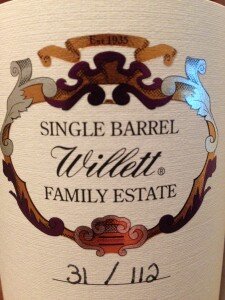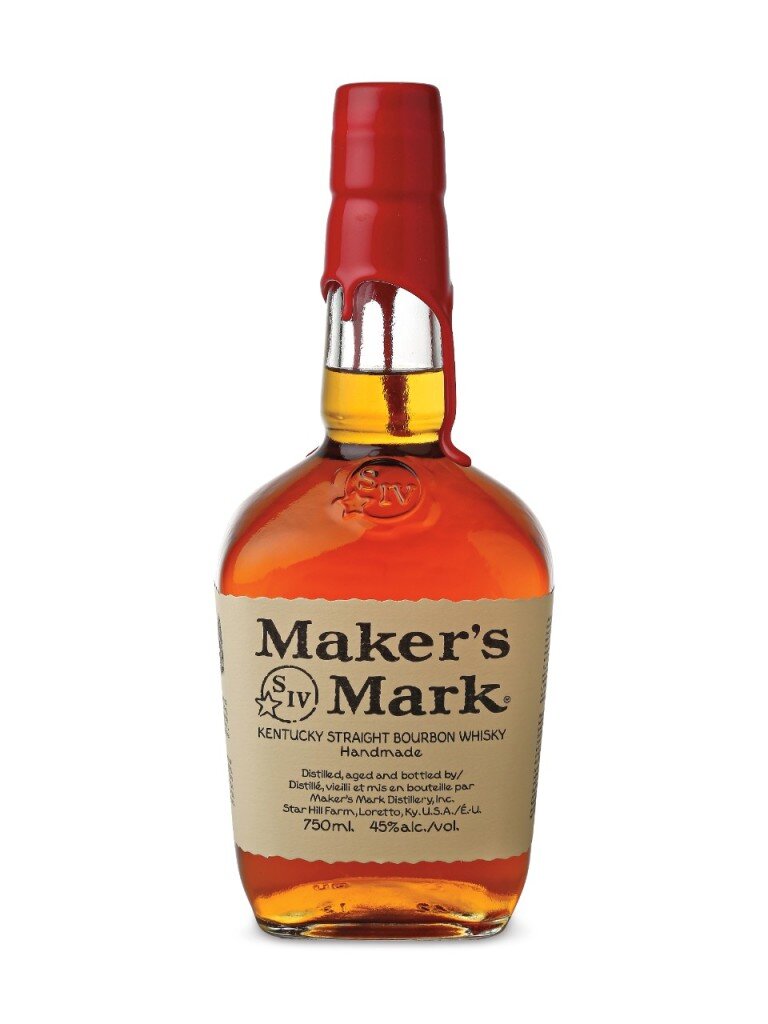The Bourbon Crusaders partners with Maker’s Mark® for 2024 Charity Event
Maker’s Mark will Choose the Charity Beneficiary for the 2024 Bourbon Charity Crusade
For Immediate Release – June 14, 2024
Friday, June 14, 2024 - LOUISVILLE, KY. – On National Bourbon Day, the Bourbon Crusaders today announced Maker’s Mark as the distillery partner for the much-anticipated 2024 Bourbon Charity Crusade.
This ticketed event will be held on November 9, 2024, in Louisville and promises to deliver an extraordinary evening featuring rare tastings, dinner, a silent and live auction, an opportunity to mix and mingle with master distillers and bourbon celebrities, and more. A separate VIP fantasy camp experience, the unique location, and charity partner will all be announced this summer. Tickets, which typically sell out immediately, will go on sale in September 2024.
The Bourbon Crusaders, a 501(c)(3) charitable organization, have carved a path by collaborating with top distilleries to auction off extremely rare and one-of-a-kind bourbons and barrel experiences that have become the stuff of bourbon lore. Since their inception in 2016, the Crusaders have raised over $7 million for local charities, making a monumental impact on communities across Kentucky. This year, Maker’s Mark will choose the charity that will benefit from 100% of the event’s proceeds, ensuring that every dollar makes a difference.
Maker’s Mark, a certified B-CorpTM, is the iconic Kentucky Bourbon driven by the vision for better flavor and a better world. “Partnering with the Bourbon Crusaders for the 2024 Charity Bourbon Crusade is an honor and a thrill for Maker’s Mark,” said Rob Samuels, eighth generation whisky maker and Managing Director, Maker’s Mark. “This partnership is a fantastic opportunity to combine our passion for exceptional bourbon with a deep commitment to supporting organizations that create a positive impact in Kentucky,”
Over the years, the Bourbon Crusaders have auctioned off historically notable bourbon barrels, setting records along the way, including:
The Ultimate Maker’s Mark Private Selection Experience
Two Willett 19-Year Bourbon Private Barrel Selections
Four Roses Extra Aged Private Barrel Selection and Experience
Two First-Ever Old Forester President’s Choice Barrel Selections
Four Roses Private Barrel Selection with Brent Elliott
Angel’s Envy Cask Strength Bourbon Private Selection
First-Ever E.H. Taylor 9-Year Private Barrel Selection
And many, many more.
“The Crusaders’ mission is to blend a passion for bourbon with a heart of philanthropy, creating a seismic charitable impact,” said RJ Sargent, President of the Bourbon Crusaders. “With Maker’s Mark as our partner for 2024, we are poised for unparalleled success thanks to the strong purpose-driven ethos of Maker’s Mark and the continued generosity of the bourbon community.”
About The Bourbon Crusaders:
The Bourbon Crusaders are a 501(c)(3) charitable organization comprising 30 members who leverage their collective passion for bourbon to support Kentuckians in need. Since 2016, the Bourbon Crusaders have donated nearly $7 million through seven legendary charity events, becoming a symbol of generosity in the bourbon community and beyond.
About Maker’s Mark®
In 1953, in Loretto, Ky. Bill Samuels, Sr., fulfilled his dream to create a handmade and delicious bourbon. He decided to make his whisky in small batches, using soft red winter wheat to enhance the softness and sweetness. He then rotated each barrel by hand for consistency and, finally, aged each barrel to taste. While he developed the bourbon, his wife Margie Samuels ideated the bourbon’s name and label, standout bottle shape, iconic and signature look that still involves hand-dipping each bottle in red wax to this day. Together as co-founders, Bill and Margie transformed bourbon from a “commodity” into a premium handmade spirit, and today Maker’s Mark® Kentucky Straight Bourbon continues to be crafted in the same, purposeful way.
In recent years, Maker’s Mark has introduced thoughtful, super-premium innovations to its portfolio, including Maker’s Mark 46, Maker’s Mark Cask Strength, and Maker’s Mark Cellar- Aged, all Double Gold winners of the 2024 San Francisco World Spirits Competition, as well as Maker’s Mark Private Selection: the brand’s custom barrel program. Maker’s Mark is the largest bourbon distillery in the world to achieve B Corp Certification and the first distillery to achieve Regenified certification, a reflection of the brand’s dedication towards building a more inclusive and sustainable economy. For more information, visit www.makersmark.com.
For more information or to schedule an interview, contact:
RJ Sargent, President, The Bourbon Crusaders, at bourboncrusaders@gmail.com
Picking Four Roses OESO
Click the link below to read our member Taylor’s review of his experience picking barrel #41, a Four Roses OESO!
Picking Old Forester Barrel Strength
On Tuesday, August 17, the Bourbon Crusaders were led on an epic quest to pick our 38th barrel in downtown Louisville — an Old Forester barrel strength bourbon.
Our barrel-picking experience was led by Tyler Mirt, Old Forester’s knowledgeable distillery manager. We were also honored to have Brown-Forman’s renowned master distiller, Chris Morris, join us on our pick as well.
Prior to our pick, Tyler brought our group on an incredibly insightful tour of the distillery. What made an already amazing tour truly monumental was having Mr. Morris join us, as he often provided ancillary anecdotes that were enlightening in a way that only someone with 45+ years of working in the whiskey industry—with nearly 20 of those years as Brown-Forman’s master distiller—could provide.
Following our tour, we were led into one of the distillery’s Private tasting rooms, where Tyler walked us through his unique process of tasting barrels, which offered a noteworthy perspective given Tyler’s experience as a sommelier, in addition to his innate knowledge of bourbon.
This was also a special tour/tasting for our group, which we are incredibly grateful for. Not only was our group among the first to select an Old Forester barrel strength bourbon in-person at the distillery, but we also had the rare opportunity to select a barrel from five samples (as opposed to the standard three).
We were led through our pick by Brown-Forman’s Master Distiller Mr. Chris Morris and Old Forester’s distillery manager Tyler Mirt.
After a quick palate calibration (courtesy of Old Forester’s 100 proof expression), we were off-and-running, tasting through five barrel samples at barrel strength. Other than knowing that the barrels’ age were consistent with the standard Old Forester barrel strength expressions (i.e. approx 4 years old), we knew nothing about the specific proof or age of any individual barrel.
At Old Forrester, age truly is just a number given the distillery’s long-established process of heat-cycled warehouse aging. Jackie Zykan (Old Forester’s Master Taster) detailed Old Forester’s use of heat-cycling a few years ago:
“In Kentucky, it gets pretty toasty in the warehouse during the summer, so we just kind of let the barrels hang out all natural. During the winter, however, that’s when we really start to, I don’t want to use the word–force-maturation, but it’s kind of forced. Once it gets down to about the mid-60s Fahrenheit inside, they crank on the heat, and when temperature gets into about the mid-90s Fahrenheit, they turn it off. By doing that you get this tea bag effect where the temperature dips up and down, up and down, as opposed to just letting it hold still all winter long. By doing that you’re replicating seasonal cycling all throughout the winter time. This is an old practice; it’s not something new. This is something everyone used to do but now it’s just a matter of whether or not they wanted to maintain the cost. It’s an expensive process to heat cycle.”
Now, back to the pick! After quietly and judiciously tasting through each of the five samples, we were asked to eliminate two of the five samples.
After tallying votes for what three barrels were liked the most up to that point, barrel numbers 2 and 4 received the least amount of votes, and were eliminated. With barrels 1, 3 and 5 remaining, it took another round of deliberation to find our near-unanimous winner — barrel #5!
Our commitment to picking barrels blind was undoubtedly highlighted with this barrel — although we later learned our selection was the highest proof (132.1) of our five options, it was also the youngest of the bunch by a few months, with a barrel date of 5/21/17. Again — age is just a number!
Embodying Old Forester’s notorious banana profile, one of our members noted our selection was “supposedly the bruiser” given our selection was the highest proof, but he “didn’t find it overly powerful—just delicious.”
We’re beyond thrilled to have picked a delicious and well-balanced barrel. And once again, cheers and thank you to Tyler and Mr. Morris for guiding our group through an incredible tour-experience and barrel selection!
Picking Elijah Craig Barrel Proof
Click the link below to read our member Taylor’s review of his experience picking barrel #37, an Elijah Craig Barrel Proof!
Wilderness Trail Has Arrived
Our Wilderness Trail bourbon is IN and we could not be more excited. These guys may be new but they absolutely know what they’re doing.
The nose is terrific, with some excellent baking spices on the palate but the finish — the finish does not go away. We’ll have more tasting notes for you shortly (head over to the release page for more information) but for now that’s enough typing, I’ll be sipping on this for the rest of the evening. Cheers!
Welcome to the New Website
Welcome to our new website! While you’re enjoying how beautifully smooooth everything is also please note: we finally got off our collective asses and put together an authoritative listing of all our releases (we’ve done 36 as of this blog post which seems both wonderful and insane in equal parts).
Please let us know if you have any feedback - and stay tuned for a couple of exciting upcoming announcements!
Wintertime, and the Whiskey is Lazy?
We have stepped with both feet into Winter now that it is January. Starting today, the Bluegrass will dip beneath 32°F and stay there for about 5 days. What is happening inside all of those barrels camping out in their metal (or brick) tents? You can probably take any tour offered on the Kentucky Bourbon Trail™ and hear well-meaning tour guide after well-meaning tour guide explain the same story--that the whiskey spent all of Summer in an expanded state, playing in the wood outside of the charred walls of home (or even evaporating away into that great tumbler in the sky), then, after growing tired from all of that play, retreating back inside to get tucked into its American White Oak bed by Mother Winter.Is it true, as the Van Winkles might say, that whiskey in the Winter is "asleep . . . in the wood"? Yes and no.I am personally familiar with the story, and I have always heard that 45°F is the magic point at which whiskey decides to take its slumber. I never gave that hard number much thought as so many variables can affect the volatility of a liquid. Temperature, humidity and pressure are just a few. Physics teachers will tell you that things expand as they are heated. As temperature drops, those same things contract. Whiskey, therefore, expands into the barrel staves, passing through the char layer in the hotter months, and contracts back through the char layer into the barrel in the colder months. I am sure, scientifically, there is a way that, if you have a few constants like chemical composition, humidity or pressure, you can calculate the exact temperature at which a whiskey will no longer pass through the char layer. Let's save that for someone's thesis.Recently, a member of our group that is in the supply-side of the "industry" was told by an unnamed American whiskey maker that the magic point was 60°F. To me, a 60°F magic point is just too high. If that was the case, the whiskey at Hillrock Estate in Ancram, New York or WhistlePig in Shoreham, Vermont would spend most of the year not "aging." A large portion of this group member's business involves Scotch, and his memories of the weather in Scotland immediately set off alarm bells at such a high magic point. He asked a few experts in the Scotch industry for their thoughts. One shot back this quick quip: "For reference the average warehouse temp in Scotland is 54°F so let's hope global warming kicks in soon so we can start making whisky here at some point." And another had a little more to say:
There is certainly some truth in this statement; in cooler conditions, there is much less wood extraction, higher temperatures tend to drive flavour out of the wood. This is one of the primary reasons that most US whiskies are bottled at much younger ages than Scotch malt.
It is, not, however, true to say that the whisky lies 'dormant'; there are degrees of oxidative ageing, which while not driving wood-derived flavours, will result in the production of many molecules giving fragrance and complexity, such as di-ethyl acetal, which is responsible for some of the herbal/minty notes in whisky.
If conditions are also damp, this helps encourage oxidative ageing. And for what this is worth, I believe that Yoichi is my favourite Japanese whisky because in Hokkaido, where the stock is aged, conditions are cooler and damper than in Honshu, the main island of Japan, hence Yoichi's Scotch-like complexity.
But those comments are only good for Scotland and Japan, right? What about in Kentucky where so much of the world's bourbon spends its days?Reid Mitenbuler, in his book Bourbon Empire: The Past and Future of America's Whiskey, devotes a page to information provided by Brown-Forman's Master Distiller Chris Morris that might support the argument that whiskey goes "dormant" in the colder months. Chris Morris noted, as Reid put it in "very general terms," that some barrels in the Brown-Forman warehouses have temperature probes that will turn on a heating system once the temperature inside the barrels dips to, get this, 60°F!¹ At the same time, Chris Morris says, "Hot or cold, you have material from the wood being absorbed by the spirit."²Jim Rutledge recently dropped into a Four Roses tribute group on Facebook to matter-of-factly give his thoughts on, among other things, the idea of whether whiskey will go "dormant" during colder months. Here is what Jim thinks: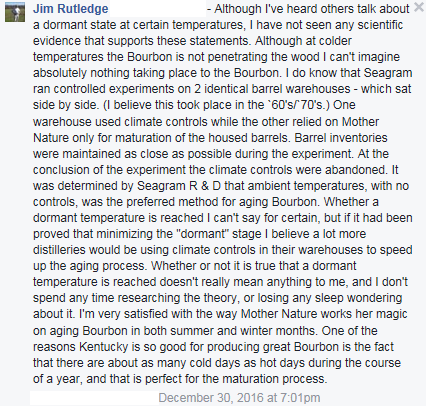 Maker's Mark seems to agree with Chris Morris that, hot or cold, the whiskey will pull some flavor from the wood. Just look at Maker's 46, which is aged in barrels containing suspended French oak staves toasted to the specifications of Recipe No. 46 and, until recently, was only aged in the cooler months. Now, Maker's Mark is building a limestone cellar to age Maker's 46 in a cooler environment year round.So, "dormant" or not, whiskey does not stop evolving. You cannot flip a switch and turn chemistry on or off.What does happen to whiskey during the colder months? You'd be surprised, but that is a tale for another day. ¹Mitenbuler, Reid. Bourbon Empire: The Past and Future of America's Whiskey. New York, NY: Penguin Books; 2015, p. 151.²Id.
Maker's Mark seems to agree with Chris Morris that, hot or cold, the whiskey will pull some flavor from the wood. Just look at Maker's 46, which is aged in barrels containing suspended French oak staves toasted to the specifications of Recipe No. 46 and, until recently, was only aged in the cooler months. Now, Maker's Mark is building a limestone cellar to age Maker's 46 in a cooler environment year round.So, "dormant" or not, whiskey does not stop evolving. You cannot flip a switch and turn chemistry on or off.What does happen to whiskey during the colder months? You'd be surprised, but that is a tale for another day. ¹Mitenbuler, Reid. Bourbon Empire: The Past and Future of America's Whiskey. New York, NY: Penguin Books; 2015, p. 151.²Id.
Cocktail Accessory Review: BDX Cocktail Cube
I heard about the Booker & Dax Cocktail Cube recently, and speaking as an enormous fan of everything Dave Arnold (the bar, the book, the Searzall) I knew that I had to pick one up.If you didn't click on the link, the Cocktail Cube has a great backstory, and I'll let Mr. Arnold tell it himself.
For years I scoffed at the numerous bartenders I heard wax poetic on the virtues of shaking cocktails with one big ice cube. One year in front of a large audience I ran a test intended to prove that big ice cubes were all show. I shook with different types of ice and dumped the drinks into graduated cylinders to measure the amount of foam the shaking had produced. To my surprise, and embarrassment, the large cube had a positive, repeatable effect on foam quantity. I don’t know why the big cube does a better job, it just does.
The Cocktail Cube is a 2-inch block of high density polyethylene which feels exactly like an ice cube in the shaker. Large ice cubes are a luxury, and wasting them on a shaken cocktail is not ideal, so the idea here is that you put the cube in the shaker alongside the cocktail and other ice.Obviously I couldn't just take his word on it (although honestly I definitely could, the man is a genius) so I ran a side-by-side with both a gimlet and a daiquiri with and without the Cube.The bottom line here is that all other things being equal (I made sure to keep both versions identical, down to the number of ice cubes used to shake with) the Cocktail Cube really does affect the viscosity of the drink in a good way. The drinks I shook with the Cube were both lighter-feeling (good for the citrus-based daiquiri and gimlet) and tasted better. I'll be using it in my shaken drinks from now on.
Another Blind Tasting (Part 2) - Smooth Ambler Low Ryes & Buffalo Trace Experimental Wheated
RecapI enjoy doing blind tastings, as you can see HERE, HERE and HERE. The first link and most recent blind tasting relates to a spontaneous blind tasting of low rye private selection Smooth Ambler Old Scout samples and two of the Buffalo Trace Experimental Collection 12 year wheated trio. Again, thanks Steve (aka @jesteva62755).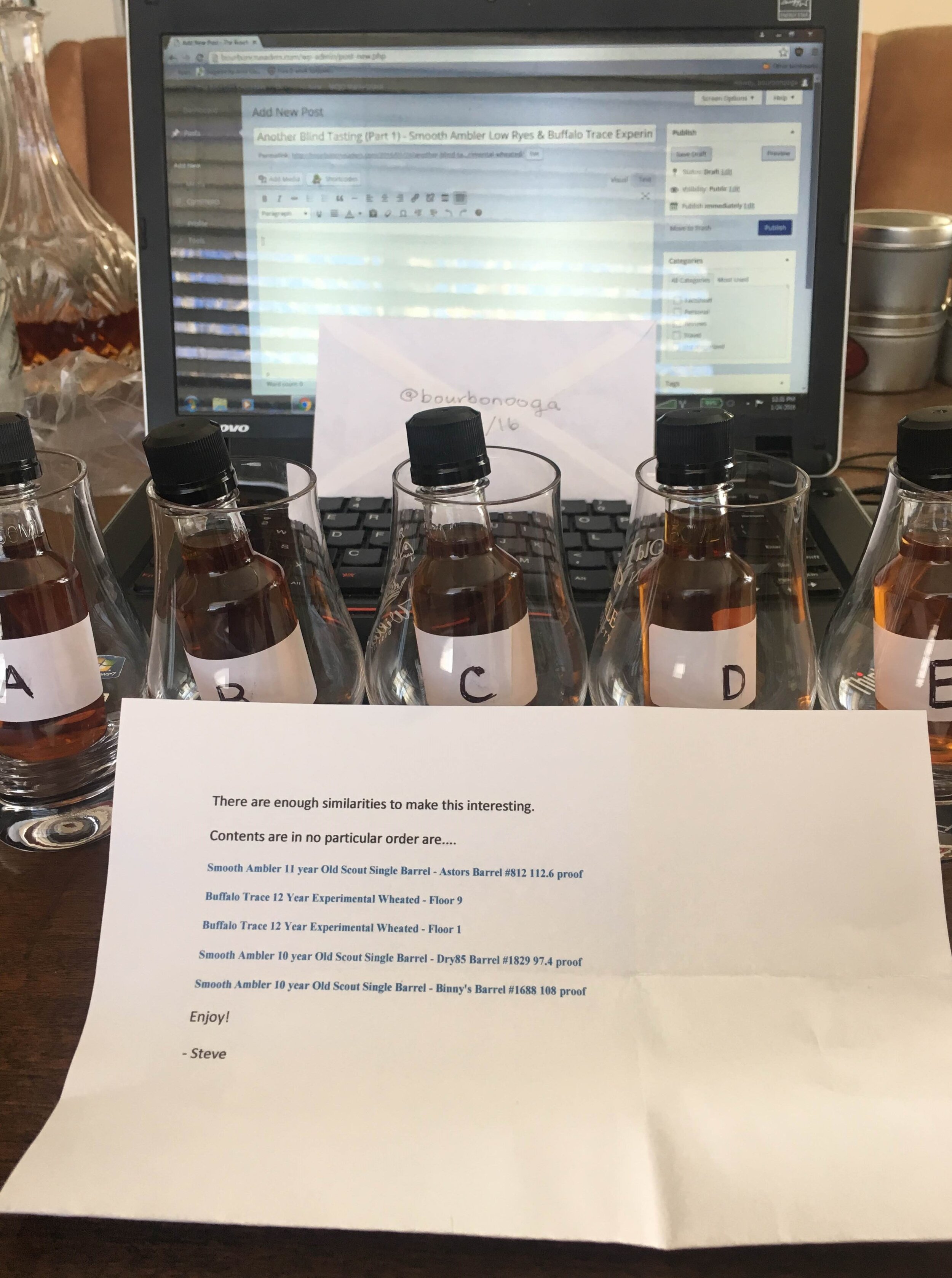 As you can see from the picture above, I knew ahead of time that the five bourbons were, in no particular order:
As you can see from the picture above, I knew ahead of time that the five bourbons were, in no particular order:
- Smooth Ambler Old Scout 11 Year Old – Astor’s Single Barrel #812 (112.6 proof);
- Buffalo Trace Experimental Collection – 12 Year Old Wheated Bourbon from Floor #9 (90.0 proof);
- Buffalo Trace Experimental Collection – 12 Year Old Wheated Bourbon from Floor #1 (90.0 proof);
- Smooth Ambler Old Scout 10 Year Old – Dry85 Single Barrel #1829 (97.4 proof); and
- Smooth Ambler Old Scout 10 Year Old – Binny’s Single Barrel #1688 (108.0 proof).
In Part 1, I gave my background and methodology for this tasting as well as my notes and guesses for each of the five samples. In this Part 2, I will reveal the results and briefly discuss the second part of the blind tasting where I tried to guess the same samples based on memory after my wife randomized the samples from Samples A-E into Samples 1-5. I will close with a few thoughts and lessons learned.Part 1 RevealSample AGuess: Smooth Ambler Old Scout 10 Year Old – Binny’s Single Barrel #1688 (108.0 proof)Result: Smooth Ambler Old Scout 10 Year Old – Binny’s Single Barrel #1688 (108.0 proof)Sample BGuess: Buffalo Trace Experimental Collection – 12 Year Old Wheated Bourbon from Floor #1 (90.0 proof)Result: Buffalo Trace Experimental Collection – 12 Year Old Wheated Bourbon from Floor #9 (90.0 proof)Sample CGuess: Smooth Ambler Old Scout 10 Year Old – Dry85 Single Barrel #1829 (97.4 proof)Result: Smooth Ambler Old Scout 10 Year Old – Dry85 Single Barrel #1829 (97.4 proof)Sample DGuess: Smooth Ambler Old Scout 11 Year Old – Astor’s Single Barrel #812 (112.6 proof)Result: Smooth Ambler Old Scout 11 Year Old – Astor’s Single Barrel #812 (112.6 proof)Sample EGuess: Buffalo Trace Experimental Collection – 12 Year Old Wheated Bourbon from Floor #9 (90.0 proof)Result: Buffalo Trace Experimental Collection – 12 Year Old Wheated Bourbon from Floor #1 (90.0 proof)Obviously, I did not get 100% right. But, I do note that I was able in Part 1 to correctly identify the low rye pours versus the wheated pours. I was also able to discern the proof between Samples A and D against Sample C. My guesses on Samples A and D were simply a coin-toss. After Part 1, I would have ranked the pours something like A > D >> C >> E > B. I would buy a case of the Binny's #1688 if I found it in the wild. ISO!Part 2 RevealIn Part 2, my wife took Samples A-E and poured the last half of each sample into five new glencairns labeled Samples 1-5. She randomized the samples so that Sample A was not necessarily Sample 1 during Part 2. Part 2 took place about 24 hours after Part 1. I decided that the easiest thing would be to pick out the wheated samples from smell alone and to concentrate on those two to decide which might be Floor 1 or Floor 9. After that, I looked primarily to the color and nose to pinpoint Sample A, and I was left with Samples C and D. Sample C during Part 1 had a peculiar taste that I did not get in Part 2. Both Samples C and D improved over the course of the day so my guesses on Samples C and D were almost a coin-toss like with Samples A and D in Part 1, but I was more confident this time around between Samples C and D than I was with Samples A and D in Part 1.Sample 1Guess: Sample A ("definitely Sample A")Reveal: Sample ASample 2Guess: Sample CReveal: Sample CSample 3Guess: Sample B ("definitely BTEC")Reveal: Sample ESample 4Guess: Sample DReveal: Sample DSample 5Guess: Sample E ("definitely BTEC")Reveal: Sample BTherefore, as I did in Part 1, I correctly guessed 3 of the 5, with the two incorrect guesses related to the wheated bourbons.Takeaways from this Blind Challenge
- Steve is a great, generous bourbon brother. This tasting was not the first time that he hit me with a bourbon bomb. He has store credit with me. Bourbon friends are good friends.
- I need a bottle of Binny's #1688. This bottle could easily best any of the four batches of Elijah Craig Barrel Proof that I have tried. This one has a lot in common with great Willett Family Estate bottles in the 10-14 year range or with 2013 or 2015 George T. Stagg cut with water (this may be better than I remember 2014 George T. Stagg). I think this bottle goes to show that MGP can put out a bourbon that would be worthy of many Top 10 lists out there. I stick by my 8.5 to 9.0 range on this bottle--it is at least 8.5, likely 8.75 with a theoretical vacuum limit of 9.25. This one pushed all the right buttons, and I will definitely keep its profile in mind should the Crusaders ever venture to West Virginia.
- I prefer at least 100 proof and some rye in bourbon. I am biased toward big, bold, spicy, rich, dessert-like bourbons at the moment.
- In line with #3, I think it might be easier than one thinks to differentiate no-rye vs. low-rye. Of no-rye, low-rye, high-rye, rye, wheat, or scotch whiskies, I think the hardest distinction is between low-rye vs. high-rye.
- I was shocked to find more oak and wood spice notes in Floor 1 over Floor 9 both days when 7 months ago I correctly found more oak and wood spice in Floor 9 over Floor 5 and then over Floor 1--twice!
- If I tried this challenge again in a week, I think I would correctly find the Binny's #1688 (even without looking at the color) and know which two are the wheated bourbons. I think it would be a coin-toss on the Astor's #812 and Dry85 #1829. Ultimately, averaging both days, I would rank these as Binny's >> Astor's > Dry85 >> Floor 1 > Floor 9.
Till next time, I will just finish this glass of VOB100 6YO and Ginger Beer.
Another Blind Tasting (Part 1) - Smooth Ambler Low Ryes & Buffalo Trace Experimental Wheated
IntroductionI enjoy doing blind tastings. I especially enjoy blind tastings that spontaneously show up in my mailbox. Today, thanks to @jesteva62755 (aka Steve), I am going to do the first of a two-part blind tasting involving low rye, private selection single barrel bourbons from Smooth Ambler and experimental wheated bourbons from Buffalo Trace.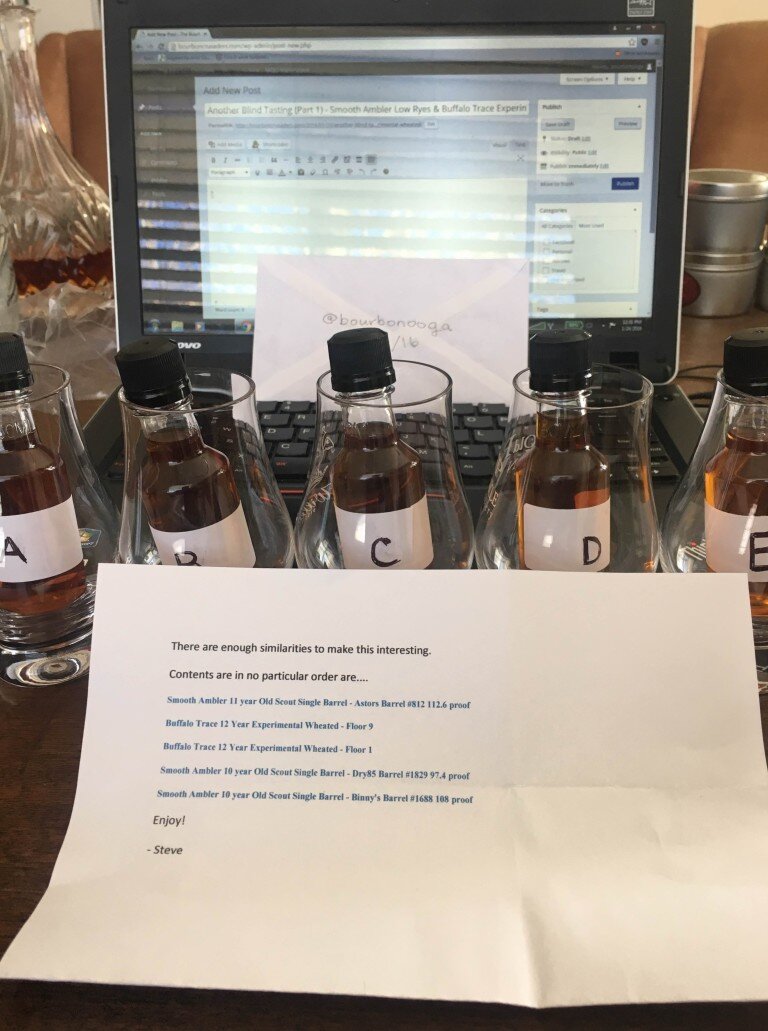 As you can see from the picture above, I know ahead of time that the five bourbons are, in no particular order:
As you can see from the picture above, I know ahead of time that the five bourbons are, in no particular order:
- Smooth Ambler Old Scout 11 Year Old - Astor's Single Barrel #812 (112.6 proof);
- Buffalo Trace Experimental Collection - 12 Year Old Wheated Bourbon from Floor #9 (90.0 proof);
- Buffalo Trace Experimental Collection - 12 Year Old Wheated Bourbon from Floor #1 (90.0 proof);
- Smooth Ambler Old Scout 10 Year Old - Dry85 Single Barrel #1829 (97.4 proof); and
- Smooth Ambler Old Scout 10 Year Old - Binny's Single Barrel #1688 (108.0 proof).
BackgroundI have had the experimental wheated collection before during another two-part blind challenge made possible by another of Steve's friendly whiskey bombs. I cataloged my results on my Twitter account (@bourbonooga) back in late May and mid June 2015. That blind challenge involved five different wheated bourbons from Buffalo Trace, and I correctly picked during both rounds each of Floors #1, #5 and #9. Hopefully, I have similar success in the first part of this blind challenge. I suspect that the key will be to identify either a strong wheated bourbon or Buffalo Trace characteristic, and, if I can spot the two wheated bourbons correctly, I will need to then think about which one has that mustier Buffalo Trace Warehouse C funk that would likely mean it is Floor #1 or which one has more oak or boldness throughout that would likely mean it is Floor #9.I have had several Smooth Ambler Old Scout products, but I have not had any of the barrels involved in this tasting. I currently have two 9 year old Smooth Ambler Old Scout single barrels--one selected by McScrooge's (Barrel # 48.5% abv) and one released by Smooth Ambler (Barrel #1889, 55.9% abv). I suspect that proof and possibly a rye spice/heat bite will be the key to identify whether a pour is one of the low rye Smooth Ambler bourbons or one of the wheated Buffalo Trace bourbons.MethodologyIn Part 1, I will pour half of each sample (25mL) and simply taste through each and make my guesses. I will not open the sealed answer key until after completing Part 2. For Part 2, which will be done the very next day, I have asked my wife to randomize samples A-E, and I will try to then guess which pour was which letter from the previous day. Therefore, Part 1 is a test upon my ability to guess a particular whiskey from a known list using taste, deductive reasoning and (some) palate memory (re: Floors #1 and 9), and Part 2 is a test upon my palate memory a day apart.
Notes for Part 1Sample ASample A is considerably darker than all of the other samples.Sample A smells rich and decadent. The legs take forever to slide down, and they seem to rather stick at the whiskey line and sprout thick whiskey tears that cling to the glass like icicles than to glide back down into the whiskey pool like usual. I pick up oak, caramel, pepper, spicy mustard and a little bit of dark chocolate. Based on nose alone, Sample A is head and shoulders above the others.Sample A tastes great. Lots of oak and caramel working with rich, warm dessert flavors like cinnamon, vanilla and chocolate.Sample A finishes all over the tongue, with a slight bitterness at the back roof of the mouth. The finish is rather long with more tingling in my mouth than down my gullet. It is mostly oak. It is a little sour and salty. I am most reminded of those chocolate and hazelnut filled wafer sticks (like Pepperidge Farm's Pirouette sticks).The proof on Sample A is definitely higher than Sample B.Sample BSample B is not as dark as Sample A, but they are more similar to each other than Sample C and Sample E are to each other. However, Sample B and Sample D are about as similar to each other as Sample C and Sample E.Sample B starts out with some acetone and marker, but there is also some red berry and uncharred oak. The oak comes across more like a higher-aged Elijah Craig (18 or 21 year bottles). I am also smelling cinnamon red hots and honey. Hiding behind the acetone is a bit of almond and marshmallow. The legs are slow and thin, but there are not many legs.Sample B tastes better than it smells. I still get acetone as I go in for a sip, but the flavors are much more like a muted wheat whiskey. Grain flavors are muted, and I get some cherry and vanilla.The finish is short and hard to place anything by the time it is gone.Sample CSample C is the lightest of all of the samples, but it is close in color to Sample E.Sample C has more caramel than Samples A and B. I am not getting much other than caramel, oak and leather. It smells thin, and the legs move quickly down the glass despite being thick.Sample C tastes interesting. I would not have guessed this was a bourbon. It almost tastes like a blended scotch. Lots of honey and a bite of spice. This also tastes the youngest of the group because I get a lot grain character that has not been worked off with the aging process. I know everything is at least 10 years old, but I would have pegged this at 6-8 years without seeing the list.The finish tastes like a Buffalo Trace warehouse smells, which is only adding confusion. But, I know there are two Buffalo Trace wheated bourbons, and Samples B and E taste so similar when compared to Sample C. Sample C is an outlier in this group of five whiskies.The proof seems lows.Sample DMost like Sample B's color.Sample D initially reminds me of Sample A. After a few minutes of air, it actually starts to smell a lot like Sample C.Sample D tastes great. I get similar warm, rich dessert flavors like Sample A, but those flavors are not as intense.The finish is square on the center of the tongue and no bitterness. The finish is relatively long--not as long as Sample A, but certainly longer than Samples B and C, and I get charred oak, pepper spice and almost like that MGP rye dill pickle flavor.Sample ESample E is light and similar to Sample C.Sample E initially reminds me of Sample B. There is an instant hit of green oak and red berry. This one has less acetone at the front. It is interesting that this and Sample B could be Buffalo Trace wheated bourbons because if I did not see the list my nose would be leading me toward whether one is Elijah Craig 18 and the other is Elijah Craig 21. After a few minutes of air, I pick up buckwheat pancakes and maple syrup.Sample E is very similar to Sample B on the taste, but it is a bit richer in flavor--there is more oak, more caramel, and the red fruit is brighter and more in your face.The finish on Sample E is slightly longer than Sample B. I even get a bit of toasted marshmallow and almond on the finish. The finish may be the best part of this whiskey.The proof seems higher than Sample B, but if this is Buffalo Trace and they are the same proof, then I attribute the extra kick on this one to more charred oak coming up.All of this means that I think this would be Floor #9 instead of Floor #1 if Samples B and E are the Buffalo Trace wheated bourbons, as I suspect.Guesses for Part 1Sample A - Clearly the best nose. The best taste, and either the best finish or second-best finish. Sample A tasted like it had the highest or second highest proof. I guess that this is the Smooth Ambler Binny's pick. Really, this was a coin toss between the Binny's and Astor's based on proof and the fact that each pick good private barrels.Sample B - The worst nose. Probably 4th in taste and 5th in finish. I guess that this is Buffalo Trace Floor #1.Sample C - Between this and Sample D for runner-up on nose. The taste is dead last. The finish is middle of the pack or maybe 4th. I guess that this is the Smooth Ambler Dry85 pick.Sample D - Possible runner-up on nose with Sample C. The runner-up on taste. The finish either 1st or 2nd. Sample D tasted like it had the highest or second highest proof. I guess that this is the Smooth Ambler Astor's pick. Really, this was a coin toss between the Binny's and Astor's based on proof and the fact that each pick good private barrels.Sample E - Second to worst nose. A better taste (probably 3rd). The finish is probably middle of the pack or 4th. I guess that this is Buffalo Trace Floor #9.Bottom LineI think Samples A and D are a step ahead of the other three to the tune of at least 0.5-1.0 points on my scale if I had more time to do a full taste and ranking. Sample A was very, very good, and I think I am going to need to hunt down a bottle. Off the top of my head, I could see this scoring anywhere from 8.0 to 9.0 (yes) on my scale. Sample D would be more like 7.5 to 8.0. Sample B came in last, but it was still a good bourbon and likely would fall in the 6.5 to 7.0 range in my scale. Sample D and E would rank similarly. These were not bad or even average bourbons. Above average across the board. I thought that the Buffalo Trace wheated bourbons would win the day (and that still may be the case), but I get the feeling that my two favorites are Smooth Ambler picks that are just bolder and more in your face. Plus, wheated bourbons tend to lack the rich dessert character that I have grown to prefer in my bourbons.Going into Part 2, I would say that Samples B and E should be easy to remember on smell, and Sample A should be easy to remember on taste and finish. I am going to look for Sample C by looking for that weird non-bourbon taste.
The "Wife is Out of Town Blind Challenge" Samples F-J / Results and Debriefing
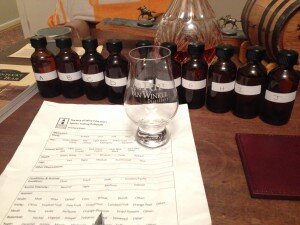 As you can read HERE, I recently did a 10-day/10-sample blind challenge. After posting my results for the first five samples, this post will cover my results for the second set of samples and the final results with a debriefing.Moving on to Sample F. . .After a two ounce pour, I would rank Sample F in the 8.75 to 9.0 range.Sample F Scoresheet - PDFSample F Picture - InstagramMoving on to Sample G. . .After a two ounce pour, I would rank Sample G in the 8.0 to 8.5 range.Sample G Scoresheet - PDFSample G Picture - InstagramMoving on to Sample H. . .After a two ounce pour, I would rank Sample H in the 6.75 to 7.25 range.Sample H Scoresheet - PDFSample H Picture - InstagramMoving on to Sample I. . .After a two ounce pour, I would rank Sample I in the 6.5 to 7.0 range.Sample I Scoresheet - PDFSample I Picture - InstagramMoving on to Sample J. . .After a two ounce pour, I would rank Sample J in the 6.0 to 6.5 range.Sample J Scoresheet - PDFno picture of Sample J
As you can read HERE, I recently did a 10-day/10-sample blind challenge. After posting my results for the first five samples, this post will cover my results for the second set of samples and the final results with a debriefing.Moving on to Sample F. . .After a two ounce pour, I would rank Sample F in the 8.75 to 9.0 range.Sample F Scoresheet - PDFSample F Picture - InstagramMoving on to Sample G. . .After a two ounce pour, I would rank Sample G in the 8.0 to 8.5 range.Sample G Scoresheet - PDFSample G Picture - InstagramMoving on to Sample H. . .After a two ounce pour, I would rank Sample H in the 6.75 to 7.25 range.Sample H Scoresheet - PDFSample H Picture - InstagramMoving on to Sample I. . .After a two ounce pour, I would rank Sample I in the 6.5 to 7.0 range.Sample I Scoresheet - PDFSample I Picture - InstagramMoving on to Sample J. . .After a two ounce pour, I would rank Sample J in the 6.0 to 6.5 range.Sample J Scoresheet - PDFno picture of Sample J
THE RESULTS ARE IN. . .
Sample A:
I guessed Fighting Cock 6yr as my primary guess and Wild Turkey 101 as my backup guess despite thinking that the nose was leading me to Knob Creek 120 (McScrooge's).
The actual result? KNOB CREEK 120 (McSCROOGE'S)
Sample B:
I guessed Willett Family Estate Barrel #6430 (11yr, 12/15 gift shop release) as my primary guess and Smooth Ambler Old Scout (McScrooge's) despite thinking that the nose was all over Four Roses with all of the fruit I smelled.
The actual result? VERY OLD BARTON 100 6YR
Sample C:
I guessed Maker's Mark Cask Strength as both my primary and backup guesses because of how strongly I picked up banana and esthers.
The actual result? NOAH'S MILL 15-18
Sample D:
I guessed Elijah Craig Barrel Proof Release #7 (128.0 proof) as my primary guess and Willett Family Estate Barrel #200 (10yr, 4/15 gift shop release) as my backup guess. This pour screamed high proof Heaven Hill.
The actual result? ELIJAH CRAIG BARREL PROOF RELEASE #7
Sample E:
I knew I was on to Four Roses. I guessed an OESK ME (9yr9mo, 2/15 gift shop release) as my primary guess and the Bourbon Crusaders OESK EN (9yr7mo, 4/15 Joyal's Liquors release) as my backup guess.
The actual result? FOUR ROSES 2013 LIMITED EDITION SINGLE BARREL (OBSK - BS 3-3L)
Sample F:
I knew I was on to Four Roses. I guessed the 2015 Limited Edition Small Batch as my primary guess and the BoomTown! OESK EN (9yr10mo, 10/15 release) as my backup guess. I thought the Four Roses was softer than OB mashbills and the proof was rather low, but the pour was more complex than usual. I felt pretty confident in either of my two guesses. This pour made me so happy I decided to do a little sketch.
The actual result? FOUR ROSES 2014 LIMITED EDITION SMALL BATCH
Sample G:
I knew again I was on to Four Roses, and I was starting to get worried that my wife closed out all of the other pours with Four Roses as well. I guessed the Bourbon Crusaders OBSV JE (9yr2mo, 9/15 Joyal's Liquors release) as my primary guess and the 2015 Limited Edition Small Batch as my backup guess.
The actual result? BOURBON CRUSADERS OESK EN (9YR10MO, 9/15 JOYAL'S LIQUORS RELEASE)
Sample H:
I picked up early on Buffalo Trace type characteristics that had me thinking about Old Weller Antique and Elmer T. Lee. Ultimately, I decided that the red fruit and higher proof was more wheater than Ancient Age mashbill so my primary guess was Old Weller Antique (standard) and my backup guess was Old Weller Antique (McScrooge's). Although, being set on a wheater, I had some internal struggle about whether this was "Poor Man's Pappy" as I had in my last blind challenge poured by my wife.
The actual result? OLD WELLER ANTIQUE 107 (STANDARD)
Sample I:
I thought I was back on to more Buffalo Trace juice, and I guess Poor Man's Pappy as my primary guess and Elmer T. Lee as my backup guess.
The actual result? ELMER T. LEE
Sample J:
Just like the streak of Four Roses, I was sure I was on to Buffalo Trace again. My primary guess was Elmer T. Lee because of the pepper. However, there was something I was not that familiar with so I also thought of a PH Ambler Contravention vatting I received from @jesteva62755 that is a blend of Parker's Heritage 8 and Smooth Ambler Contravention.
The actual result? BUFFALO TRACE
THE DEBRIEFING
With the final results in, I scored slightly worse than I expected. I got two pours exactly right, one backup guess right and all of the Four Roses origin pours correct. I allowed my taste and gut to lead me astray on the first pick with the Knob Creek 120 (McScrooge's) that might have set the tone for the rest of the challenge. I also whiffed rather hard on Samples B and C.
What I learned from this challenge is A) I drink Four Roses too much, but not enough, B) I need to put more attention to 10yr and younger Beam and Heaven Hill products and C) I [fortunately] have much more work to do.
What I was most surprised by in this challenge are the results from Sample C (Noah's Mill 15-18) and Sample E (Four Roses 2013 Limited Edition Single Barrel). The Noah's Mill did not taste like my last imprint (read: better). The 2013 Limited Edition Single Barrel was a letdown (relatively - with its 8.25 to 8.75 blind range score) considering it was an immovable feature in my Top 3 All Time list. My one and only bottle is now 2.5 years old and on its last 2 or 3 pours so I am saddened to think this one has lost a bit of sheen.
The ten pours ranked from best to worst as follows:
- Four Roses 2014 Limited Edition Small Batch;
- (tie) Elijah Craig Barrel Proof Release 7 (128.0 Proof);
- (tie) Four Roses 2013 Limited Edition Single Barrel;
- Bourbon Crusaders Four Roses OESK EN 9yr10mo 9/15 Joyal's Liquors release;
- Noah's Mill 15-18;
- Very Old Barton 100 6yr;
- Old Weller Antique 107 (standard);
- Elmer T. Lee;
- Buffalo Trace; and
- Knob Creek 120 (McScrooge's).
In conclusion, it appears that I ranked my picks rather accurately along the lines of limited edition (1 and 3), higher-end regular releases (2 and 5) and great, recent batches (4 and 5) being better than standard releases (7 through 9), with the only outlier being the Knob Creek 120 "Hand Selected For" (not "By") McScrooge's, which in a prior Knob Creek 120 blind sample finished 4th of 5 different picks and got a C/C- rating. Nevertheless, I cannot stop until I get a bowl a 300.
The "Wife is Out of Town 10-Day Blind Challenge" / Overview & Samples A-E
 I enjoy doing blind tastings. I think it is interesting when you taste something blind and miss that one tell-tale key to the answer--Jim Beam and peanut, Maker's Mark and banana/ester/Belgian beer or Four Roses and mint/citrus/Juicy Fruit gum. That missing tell-tale key is the proof that more work is needed, and work in this case is tasting more whiskey. If anyone reading this follows me on Twitter or Instagram (@bourbonooga), you might remember a few recent blind tastings that I have done: a four-sample tasting of different private Knob Creek 120 picks; a five-sample Buffalo Trace 12 year old wheated horizontal done twice with a few weeks in between the two tastings; a fourteen-sample out of then twenty-four open bottle free-for-all; and most recently a four-sample out of then fifty-eight open bottle free-for-all spread out over four consecutive nights. I had success in both blind tastings of the Buffalo Trace 12 year old wheated horizontal correctly guessing three of the five in each tasting and missing a perfect score by mixing two of my bottom three pours each time. On the other hand, I failed rather miserably in my recent four-sample free-for-all by whiffing completely the first three nights and having luck the final night by guessing that the pour was Weller 12 when it was in fact a blend of Weller 12 and Old Weller Antique 107.Now, my wife has left me and the dog to fend for ourselves for ten days in colder weather. Before she left, however, I asked her to pour another free-for-all blind tasting set, but on steroids. This post and the next are devoted to a ten-sample free-for-all out of now sixty open bottles, with one pour each day or night. I will not know the answers until the end as my wife holds the Rosetta Stone for this challenge.My current open bottle inventory covers a wide swath of whiskey with high-rye bourbon, low-rye bourbon, wheated bourbon, wheat whiskeys, rye whiskeys (Canadian and American), scotch (peated and non-peated), Buffalo Trace, Four Roses, Heaven Hill, Jim Beam, MGP, Willett, Wild Turkey, Barton, homemade vats, vats from generous friends and the open bottles range from four years in age to twenty-two years in age. Four Roses dominates my liquor cabinet, but I have sixteen different bottles of Four Roses open so pinpointing the exact recipe or small batch will be difficult even if Four Roses is the most likely to be represented in this blind challenge making up 27% of my open bottle list.I will use for each pour the Society of Wine Educations Spirits Tasting Rationale score sheet simply because I find it to contain a great section on aromas and a sufficient section on taste and finish, with the added bonus that it means I have less writing to do. Instead, I can be lazy and upload PDFs of my score sheets.Moving on the Sample A. . .After a two ounce pour, I would rank Sample A in the 4.75 to 5.25 range.Sample A Scoresheet - PDF
I enjoy doing blind tastings. I think it is interesting when you taste something blind and miss that one tell-tale key to the answer--Jim Beam and peanut, Maker's Mark and banana/ester/Belgian beer or Four Roses and mint/citrus/Juicy Fruit gum. That missing tell-tale key is the proof that more work is needed, and work in this case is tasting more whiskey. If anyone reading this follows me on Twitter or Instagram (@bourbonooga), you might remember a few recent blind tastings that I have done: a four-sample tasting of different private Knob Creek 120 picks; a five-sample Buffalo Trace 12 year old wheated horizontal done twice with a few weeks in between the two tastings; a fourteen-sample out of then twenty-four open bottle free-for-all; and most recently a four-sample out of then fifty-eight open bottle free-for-all spread out over four consecutive nights. I had success in both blind tastings of the Buffalo Trace 12 year old wheated horizontal correctly guessing three of the five in each tasting and missing a perfect score by mixing two of my bottom three pours each time. On the other hand, I failed rather miserably in my recent four-sample free-for-all by whiffing completely the first three nights and having luck the final night by guessing that the pour was Weller 12 when it was in fact a blend of Weller 12 and Old Weller Antique 107.Now, my wife has left me and the dog to fend for ourselves for ten days in colder weather. Before she left, however, I asked her to pour another free-for-all blind tasting set, but on steroids. This post and the next are devoted to a ten-sample free-for-all out of now sixty open bottles, with one pour each day or night. I will not know the answers until the end as my wife holds the Rosetta Stone for this challenge.My current open bottle inventory covers a wide swath of whiskey with high-rye bourbon, low-rye bourbon, wheated bourbon, wheat whiskeys, rye whiskeys (Canadian and American), scotch (peated and non-peated), Buffalo Trace, Four Roses, Heaven Hill, Jim Beam, MGP, Willett, Wild Turkey, Barton, homemade vats, vats from generous friends and the open bottles range from four years in age to twenty-two years in age. Four Roses dominates my liquor cabinet, but I have sixteen different bottles of Four Roses open so pinpointing the exact recipe or small batch will be difficult even if Four Roses is the most likely to be represented in this blind challenge making up 27% of my open bottle list.I will use for each pour the Society of Wine Educations Spirits Tasting Rationale score sheet simply because I find it to contain a great section on aromas and a sufficient section on taste and finish, with the added bonus that it means I have less writing to do. Instead, I can be lazy and upload PDFs of my score sheets.Moving on the Sample A. . .After a two ounce pour, I would rank Sample A in the 4.75 to 5.25 range.Sample A Scoresheet - PDF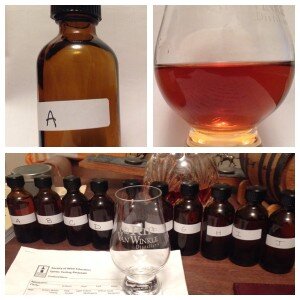 Moving on the Sample B. . .After a two ounce pour, I would rank Sample B in the 7.0 to 7.25 range.Sample B Scoresheet - PDF
Moving on the Sample B. . .After a two ounce pour, I would rank Sample B in the 7.0 to 7.25 range.Sample B Scoresheet - PDF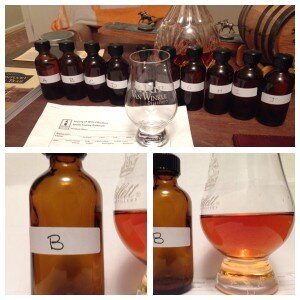 Moving on the Sample C. . .After a two ounce pour, I would rank Sample C in the 7.25 to 7.75 range.Sample C Scoresheet - PDF
Moving on the Sample C. . .After a two ounce pour, I would rank Sample C in the 7.25 to 7.75 range.Sample C Scoresheet - PDF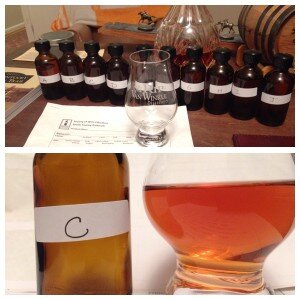 Moving on the Sample D. . .After a two ounce pour, I would rank Sample D in the 8.25 to 8.75 range.Sample D Scoresheet - PDF
Moving on the Sample D. . .After a two ounce pour, I would rank Sample D in the 8.25 to 8.75 range.Sample D Scoresheet - PDF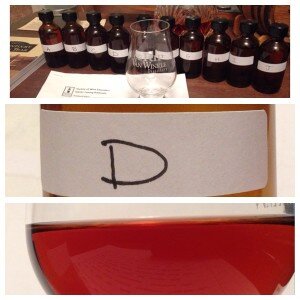 Moving on the Sample E. . .After a two ounce pour, I would rank Sample E in the 8.25 to 8.75 range.Sample E Scoresheet - PDF
Moving on the Sample E. . .After a two ounce pour, I would rank Sample E in the 8.25 to 8.75 range.Sample E Scoresheet - PDF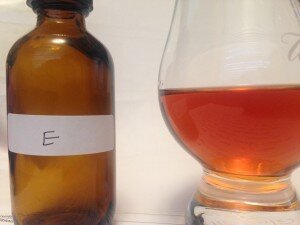 Stay tuned later this week for the final 5 score sheets and, ultimately, the big reveal.@bourbonooga's rubric:9.5-10.0 bourbon basically does not exist in my scoring system. It is a figure left for the life-altering bourbons.9.0-9.5 bourbon is as best as they come.8.5-9.0 bourbon is fantastic, and it is a mark that a limited edition release should hit. Obviously, not all do.8.0-8.5 bourbon is a bourbon that likely has one superb feature and above average remainders, or it is a bourbon that is more than above average across the board. This is a mark that a limited edition release must hit to avoid underperformance.7.0-8.0 bourbon is a bourbon that is probably above average across the board. There may be one close to average aspect about it. This is the worst bourbon that I want to pour each night when I am rich.6.0-7.0 bourbon is a bourbon with nearly every facet near average, but not yet average. Expect slightly less reviews to fall here.5.0-6.0 bourbon is average bourbon. Expect most reviews to fall here.4.0-5.0 bourbon is a bourbon with nearly every facet near average, but on the wrong side of average. Expect most reviews to fall here.3.0-4.0 bourbon is a bourbon with probably one average or near average aspect, with the others being below average. Expect slightly less reviews to fall here.2.0-3.0 bourbon is solidly below average bourbon. I suspect I could be reviewing a few of these bourbons.1.0-2.0 bourbon is bad. I hope I do not have to review many bourbons in this category.0.0-1.0 bourbon should be avoided at all costs. I highly doubt I ever review a bourbon in this category.
Stay tuned later this week for the final 5 score sheets and, ultimately, the big reveal.@bourbonooga's rubric:9.5-10.0 bourbon basically does not exist in my scoring system. It is a figure left for the life-altering bourbons.9.0-9.5 bourbon is as best as they come.8.5-9.0 bourbon is fantastic, and it is a mark that a limited edition release should hit. Obviously, not all do.8.0-8.5 bourbon is a bourbon that likely has one superb feature and above average remainders, or it is a bourbon that is more than above average across the board. This is a mark that a limited edition release must hit to avoid underperformance.7.0-8.0 bourbon is a bourbon that is probably above average across the board. There may be one close to average aspect about it. This is the worst bourbon that I want to pour each night when I am rich.6.0-7.0 bourbon is a bourbon with nearly every facet near average, but not yet average. Expect slightly less reviews to fall here.5.0-6.0 bourbon is average bourbon. Expect most reviews to fall here.4.0-5.0 bourbon is a bourbon with nearly every facet near average, but on the wrong side of average. Expect most reviews to fall here.3.0-4.0 bourbon is a bourbon with probably one average or near average aspect, with the others being below average. Expect slightly less reviews to fall here.2.0-3.0 bourbon is solidly below average bourbon. I suspect I could be reviewing a few of these bourbons.1.0-2.0 bourbon is bad. I hope I do not have to review many bourbons in this category.0.0-1.0 bourbon should be avoided at all costs. I highly doubt I ever review a bourbon in this category.
SF Crusader: Four Roses Limited Edition Small Batch 2015
I was in Kentucky earlier this year with a group of outstanding people, and had the good fortune to sample a small pour of the 2015 Four Roses Limited Edition Small Batch. While I admittedly was not the soberest I've ever been, I knew as soon as I raised the glass to my nose that I was holding something special. Coming off of the back-to-back highs of 2012's unbelievable Limited Edition Small Batch and 2013's 125th Anniversary Edition, both of which are among the best whiskies ever produced, people weren't quite as enthused about last year's (I found it pretty tasty but a definite step down from the year before), and were holding their breath to see what this year's release would bring.Once I had tasted it, I resolved to track down a few bottles even if it meant paying secondary-market pricing on some of them since I knew I wanted to have this around for a long time. These were going to be snapped up quick regardless of how it tasted, and once people realized just how good it was, they were going to be very hard to get ahold of.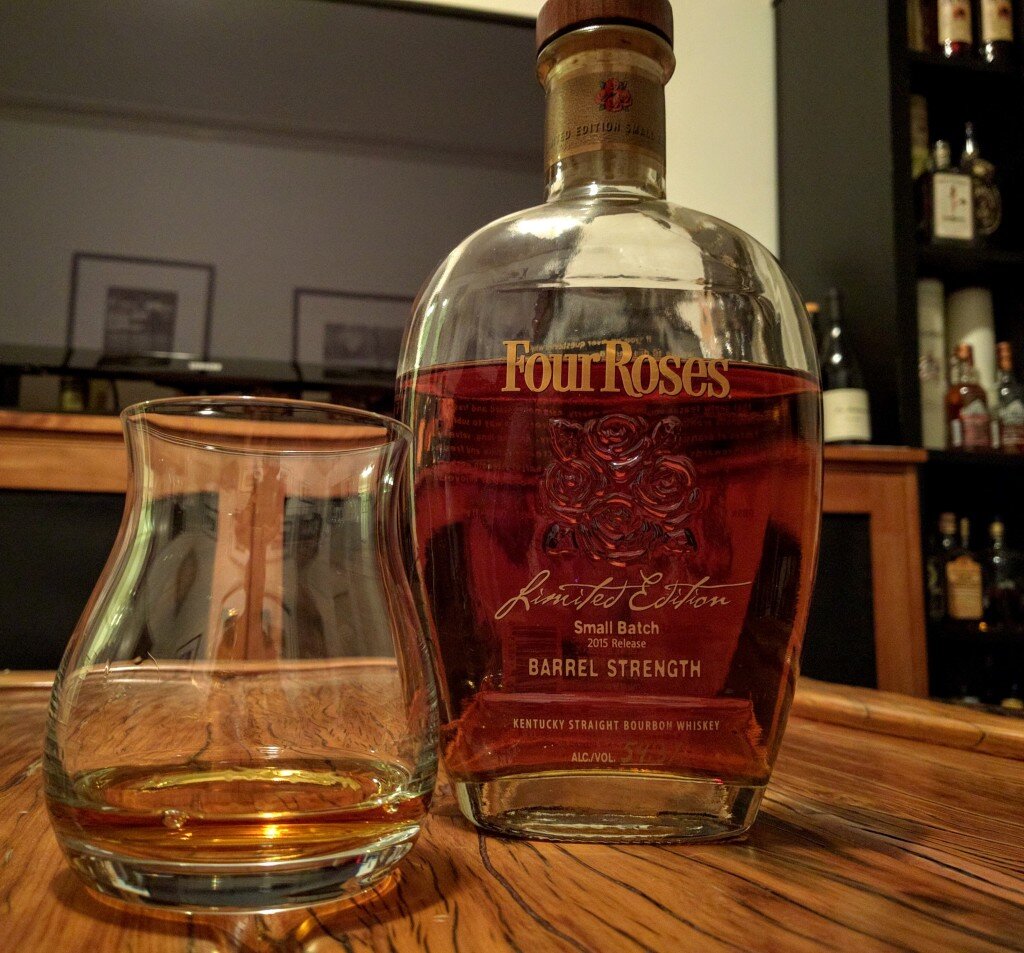 To some degree, writing reviews like this are a little silly past a few basics: is the whiskey bad, good, or outstanding? Is it worth the price of admission? Is it something that you should try at a bar, or is it worth hunting down a bottle for yourself? Beyond that, writing about a whiskey's experience is, to paraphrase Martin Mull, a bit like dancing about architecture. You can elaborate on the flavors and aromas you detect, but once you exhaust the standard repertoire of commonly-found whiskey flavors things quickly escalate into absurdity. Not only are flavor notes like "Fresh-sprayed Silly String on an hour-old apricot-mango-basil (dried basil, of course) cobbler served on a Ford F-150 tire driven coated in Mojave desert dust" thoroughly absurd, but even simpler ones like specific fruits often have very different meanings for the reviewer and the reader, if they even exist at all as reference points for the reader.To answer the fundamentals: this whiskey is outstanding. It is absolutely worth the retail price, and to me also worth a good deal more than that. And if you find a bottle of it, don't pass it up.With that out of the way, let's start dancing about architecture.On the nose there is a lick of cherry (I swear I never detected cherry this much before I started writing reviews but now that it's in my head I'm noticing that a lot of my favorite bourbons have it), or if not exactly cherry then another staining red fruit. There's a lovely baking spice aroma that fills the glass as well, and after sitting in the glass a little, some butterscotch too.The palate screams across the tongue, with a slight saltwater tannicity that barely reigns in exuberant vanilla and cinnamon spice, with a kick that drives it all home. As it rises up from the tongue back out through the nose a small flash of mint appears, along with some delicious fresh-baked dough. The finish is fantastic, with black pepper moving around the mouth like a glittering firework on the Fourth of July.Jim Rutledge knocked it out of the park with this one. Now that he's retired, Brent Elliott has some mighty big shoes to fill around this time next year, and though I look forward to trying what he puts together (and the true test will be in 8-10 years, when bourbon that he distilled will be the majority of the stock at Four Roses), this drink is in honor of Jim.Score: 4.25/5
To some degree, writing reviews like this are a little silly past a few basics: is the whiskey bad, good, or outstanding? Is it worth the price of admission? Is it something that you should try at a bar, or is it worth hunting down a bottle for yourself? Beyond that, writing about a whiskey's experience is, to paraphrase Martin Mull, a bit like dancing about architecture. You can elaborate on the flavors and aromas you detect, but once you exhaust the standard repertoire of commonly-found whiskey flavors things quickly escalate into absurdity. Not only are flavor notes like "Fresh-sprayed Silly String on an hour-old apricot-mango-basil (dried basil, of course) cobbler served on a Ford F-150 tire driven coated in Mojave desert dust" thoroughly absurd, but even simpler ones like specific fruits often have very different meanings for the reviewer and the reader, if they even exist at all as reference points for the reader.To answer the fundamentals: this whiskey is outstanding. It is absolutely worth the retail price, and to me also worth a good deal more than that. And if you find a bottle of it, don't pass it up.With that out of the way, let's start dancing about architecture.On the nose there is a lick of cherry (I swear I never detected cherry this much before I started writing reviews but now that it's in my head I'm noticing that a lot of my favorite bourbons have it), or if not exactly cherry then another staining red fruit. There's a lovely baking spice aroma that fills the glass as well, and after sitting in the glass a little, some butterscotch too.The palate screams across the tongue, with a slight saltwater tannicity that barely reigns in exuberant vanilla and cinnamon spice, with a kick that drives it all home. As it rises up from the tongue back out through the nose a small flash of mint appears, along with some delicious fresh-baked dough. The finish is fantastic, with black pepper moving around the mouth like a glittering firework on the Fourth of July.Jim Rutledge knocked it out of the park with this one. Now that he's retired, Brent Elliott has some mighty big shoes to fill around this time next year, and though I look forward to trying what he puts together (and the true test will be in 8-10 years, when bourbon that he distilled will be the majority of the stock at Four Roses), this drink is in honor of Jim.Score: 4.25/5
Four Roses 125th Anniversary Limited Edition Small Batch (2013)
Distillery: Four RosesYear: 2013Proof: 103.2°Availability: 12,468 bottles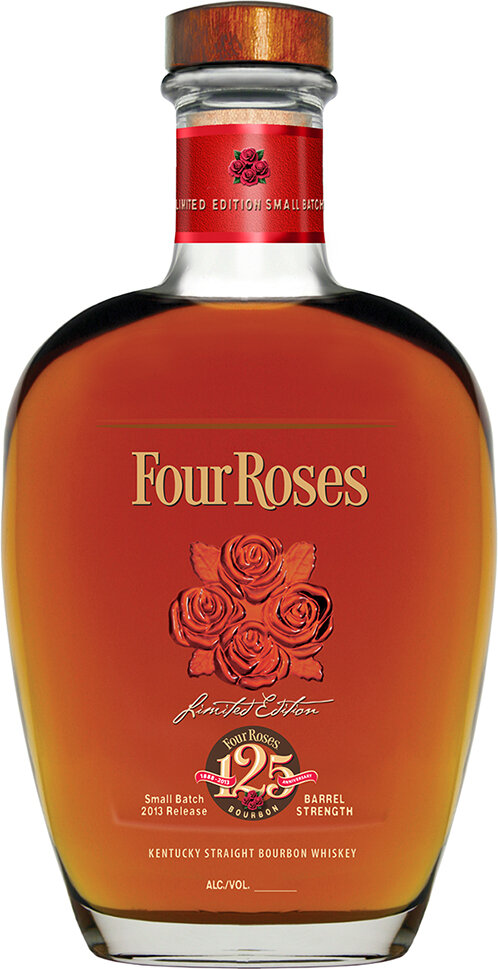
We're celebrating our 125th Anniversary with what our Master Distiller describes as "what could be the best Bourbon we've ever put in a bottle." This year's Barrel Strength Limited Edition Small Batch, created from 3 of our 10 distinct Bourbon recipes, welcomes you to the party with generous creamy vanilla, light oak and cherry cordial aromas. Bright splashes of raspberry and apricot greet the palate, giving way to subtle tones of nutmeg and cocoa. Then mellow flavors of cherry and vanilla bean define the long, luxurious finish in such a way to make you wish you could toast our 125th every year for the next 125 or more. Cheers.
The recipes: OBSV - 18 years • OBSK - 13 years • OESK - 13 yearsCrusader Reviews:SF Crusader: 4.5/5
Four Roses Limited Edition Small Batch 2015
Distillery: Four RosesYear: 2015Proof: 108.6°Availability: 12,672 bottles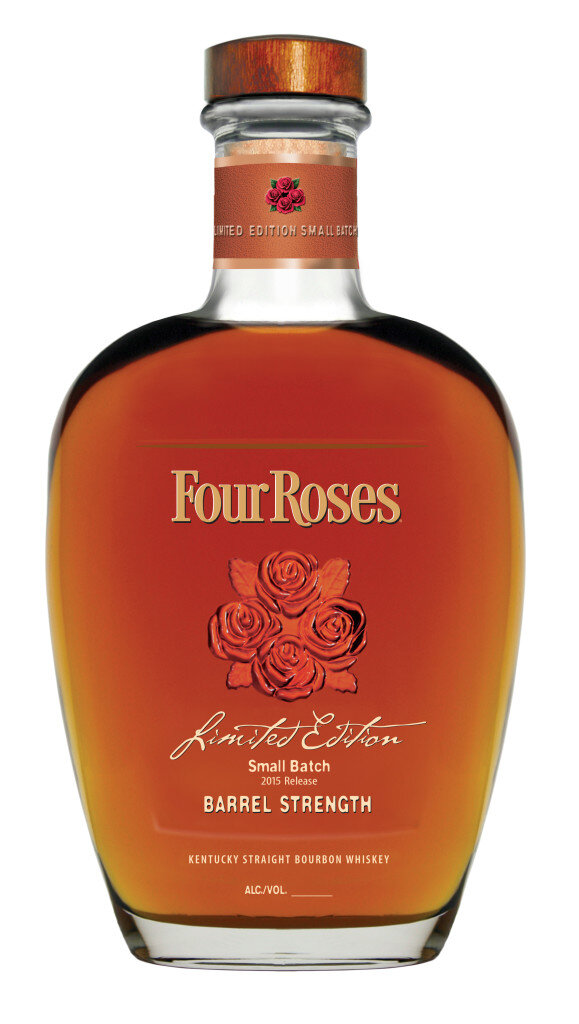
If you've ever questioned why we use 10 distinct Bourbon recipes to handcraft our award-winning Bourbon, the rich amber contents of this bottle may be the tastiest answer yet. Three of our exquisite, perfectly-aged Bourbon recipes have been mingled together to create a spirit that gently teases you with ripe cherry, caramel custard and fresh magnolia aromas. Spicy cinnamon and clove flavors give way to subtle tastes of orange peel, apricot and light honey. And the long, velvety finish rewards you with lingering hints of creamy vanilla and fresh spearmint. Here's to this delightfully complex barrel strength work of art. And here's to wishing there was only more of it to be enjoyed.
The recipes: OBSK - 16 years • OESK - 15 years • OESK - 14 years • OBSV - 11 yearsCrusader Reviews:SF Crusader: 4.25/5Notable Third-Party Reviews:Sipp'n Corn: 4.5Drinkhacker: B+
SF Crusader: Metze's Select 2015 Medley
When Metze's Select was first announced, I was a little surprised to hear about it, but more surprised that MGP hadn't done this before. I won't go far into distillery background, but they make so much whiskey that it was kind of shocking they weren't getting in on the current whiskey boom.This one seemed to fall off the radar a little - it was announced a while ago but took a long time to reach shelves, and I haven't seen many reviews of it online yet. Which is a shame, as it's a delicious bourbon. Let's get to it then.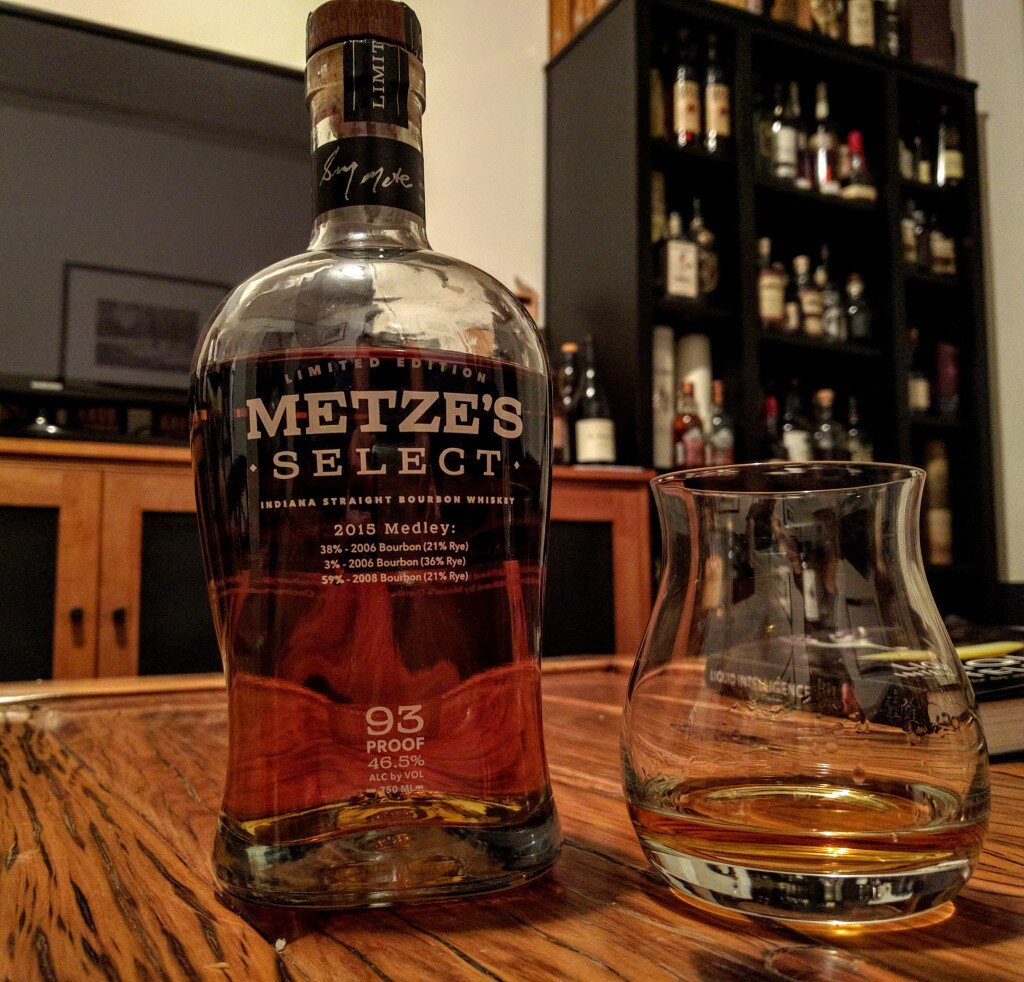 The first thing you notice is the bottle. A unique and distinctive shape reminiscent of both a teardrop and a molar tooth, it is an attractive, modern package. And it looks like a packaged unit of a product, more so than other bottles that I've noticed. This might be solely due to the fact that it is a unique design, and therefore that I'm examining it more closely, but it does have a round shiny appeal which is in some way similar to a real-life instantiation of a polished gem from a video game. It feels very sleek and "designed", if that makes sense. I asked MGP about how the bottle design was chosen but was given a pretty vague reply, "In making our selection, we wanted a bottle that would reflect the premium quality of Metze’s Select." So there you have it.One thing I really like about Metze's Select is that they make the sources extremely explicit. The bottle's front label has the following list.
The first thing you notice is the bottle. A unique and distinctive shape reminiscent of both a teardrop and a molar tooth, it is an attractive, modern package. And it looks like a packaged unit of a product, more so than other bottles that I've noticed. This might be solely due to the fact that it is a unique design, and therefore that I'm examining it more closely, but it does have a round shiny appeal which is in some way similar to a real-life instantiation of a polished gem from a video game. It feels very sleek and "designed", if that makes sense. I asked MGP about how the bottle design was chosen but was given a pretty vague reply, "In making our selection, we wanted a bottle that would reflect the premium quality of Metze’s Select." So there you have it.One thing I really like about Metze's Select is that they make the sources extremely explicit. The bottle's front label has the following list.
- 38% - 2006 Bourbon (21% Rye)
- 3% - 2006 Bourbon (36% Rye)
- 59% - 2008 Bourbon (21% Rye)
I was very curious about that second item there - only 3%? I emailed MGP asking about it and here's what they had to say:
While all three of the bourbons used in Metze’s Select are the Lawrenceburg style high rye mash bills, the splash of bourbon with 36% rye added a little extra fruity note, almost raisin-like, to make the 2015 medley an even more unique expression.
The nose is quite pleasant, predominantly sweet vanilla with almost no alcohol burn. I also get a hint of baking spices, and a little butterscotch as well. A similar nose almost to an Elmer T Lee, but with none of that slightly sour apricot tang which I've noticed in a few Buffalo Trace whiskies.Remarkably smooth (but not boring!) on the palate. This is an easy drinker for sure. After noticing the wonderful texture, some light brown sugar emerges and nicely coats the tongue. Really a delightful sipper. There's a little oak tannin but it is in no way overpowering, and adds a good light structure to the pour.The finish brings a dusting of cocoa powder and even a whisper of dill, while that brown sugar from before remains. Revisiting the nose, I get more dill,Greg Metze has put together a great whiskey. It's definitely on the lighter side of the bourbon spectrum, but although "light", "smooth" and "sweet" aren't always things that bourbon fans seek out, Metze's Select truly delivers without sacrificing depth or complexity. The relatively high proof (46.5% ABV) certainly helps here, as this would be a very different whiskey at 80 proof. It also markedly improved in the glass over the course of 10-20 minutes.Rating: 3.5/5
Metze's Select 2015 Medley
Distillery: MGPYear: 2015Proof: 93°Availability: 6000 bottlesMetze's Select 2015 Medley is an Indiana Straight Bourbon produced by MGP, the 2015 Medley is the first time MGP whiskey has been widely sold under its own brand. A blend of three bourbons, the component pieces are:
- 38% 2006 Bourbon (21% Rye)
- 3% 2006 Bourbon (36% Rye)
- 59% 2008 Bourbon (21% Rye)
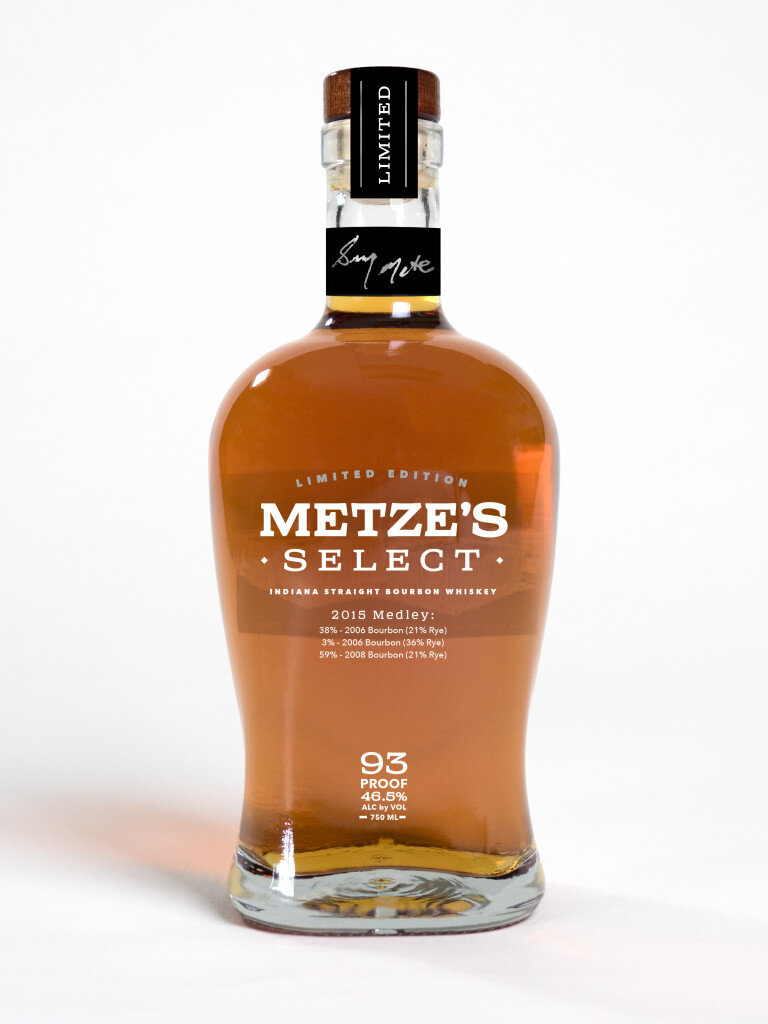 Crusader Reviews:SF Whiskey: 3.5/5
Crusader Reviews:SF Whiskey: 3.5/5
Bourbonooga: Willett Family Estate Bottled Single Barrel Bourbon C17D
What a fantastic way to kick off my Bourbon Crusaders review assignments. These reviews should become a regular staple as long as the bourbon still flows, unlike the one-off masterpiece I had the fortune to review for this installment.I think I am similar to many that took a benign interest in sipping bourbon and whiskey and turned that interest into a true hobby and pursuit in the fact that I acclimated to higher end bourbons by focusing on the limited edition Buffalo Trace releases that dominate any Google search on the topic of "best bourbon out there." So much so that I still recall the week after the Kentucky Derby in 2013 when I walked into Down One off of W. Main St. and asked if any of the hush-hush Spring Derby Pappy release was available by the pour. "No, we sold out two days ago, but we have 19 different Willett Family Estate bottlings if you prefer," was the response from a bartender that I believe was truly trying to guide me in the right direction. I declined. I was stupid. I was uneducated, and the price is tough to take without previous experience when Google is distracted on Frankfort. Luckily, I did try a few bottlings not long after. I still look to Aged Truth (Barrel No. 806, 11yrs.) as one of the best bourbons I have ever tried. I try to be careful to qualify that statement because I have not had a full bottle, but it was with that same qualification and perhaps coincidentally with my past history in 2013 that I found myself reviewing a 22-year-old wheated Willett Family Estate bottle from Barrel No. C17D...C17D was released around Derby Week in 2015--almost two years after I opted out of a 19 bottle lineup of Willett Family Estate (no doubt a few having those famous block letters)--and it comes in at a hazardous 141.8 proof (70.9% abv). Barrel No. C17D yielded 112 bottles. Bottle 31 rests comfortably in my office.
I did this tasting in two separate rounds of neat vs. water with 48 hours of rest. My notes follow.APPEARANCE:C17D is one of the 3 or 4 darkest bourbons I have ever seen in person. Upon my first sight, I considered it almost full brown with a red and purple glint when presented at an angle. The color was almost cherry wood, cedar bark or cordovan leather. Two days later, I was reminded of a well-aged cognac, and I decided that this was not a standard bourbon color. Truthfully, the only bourbons I have had that I know are darker in color are Heaven Hill Select Stock 131 proof Bottled for the Bourbon Bar and the 4th Edition of William Heavenhill (135.6 proof, 15yr.). You can see @sippncorn's review of the William Heavenhill (with a remark on the Heaven Hill Select Stock as well) HERE. For potential background on C17D's genesis, take a look at @SkusRecentEats article about an April 6, 1993 wheated run at New Bernheim that interestingly occurred approximately 22 years and 1 month before the release of C17D. You can find that HERE.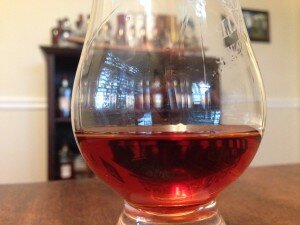 NOSE:I found C17D to be warm, but it did not singe the nose. There was a surprising amount of pepper, with oak, cherry and leather predominating. Not long after that initial nose, I was reminded of dark chocolate raspberry candy bars because there was a sugariness, almost like a donut glaze, that worked with the chocolate and cherry aspects. C17D was very sweet, but there was hefty char as well. As to be expected with a 22-year-old whiskey.After a few minutes, I could tell that there was significant red berry that wanted to come forward out across the wall of peppery heat in its way. In that respect, I thought back to 2014 William Larue Weller--another wheated bourbon north of 140.0 proof. C17D was turning into a hot, sugary red berry bomb. I suspected a cut of water would knock out the white pepper.After ten minutes of air, C17D gave hints that it was going to turn into a brown sugar, caramel and bread pudding nose. I was really enjoying the turn to a rich, dark dessert sweet as I am a sucker for that type of nose. As I neared the end of the first neat pour, I was reminded of a great cheesecake crust sitting in raspberry and caramel drizzle after you have scraped away nearly all of the cream cheese filling. There was also a touch of buckwheat and syrup. I did not want to cut this pour with water. C17D remained spicy and warm after all of those minutes, but the spice toward the end was due to the mix of dry, spicy oak, sugar and salty caramel.With water, the first neat pour lost all fruity character. I was left with salted cow tails with a spicy oak bite and cocoa dusting.After a few days of taking the air, the bottle calmed the alcohol and left merely a warm oak spice, and lots of it, with that same cherry predominating. There was less leather than the first pour, which was already not overpowering, but the leather that left after the first pour was replaced with even more sweetness. Vanillin and caramel with a faint toffee and malt bar toward the end of the caramel.A few more minutes of air for the second pour brought out that lower level rickhouse musk. The damp oak and char started to dominate the rest of the way. Some may not like this much oak, but it was not green oak. This was that smell that drapes you like a veil when you duck your head and step into Warehouse C at Buffalo Trace. Or, if perhaps Warehouse C had a damp, musky and oaky basement. This was not Pappy 20, or the 20-year-old Elijah Craig impressions. This was decades of evaporating oak mingling with damp, well-shaded oak. This was that great smell sitting at the bottom of your glencairn the next morning.The second pour did not hold up well to water. The spice really geared up and kicked with oak and leather. I was most reminded of a strong and bitter Four Roses OESO.
NOSE:I found C17D to be warm, but it did not singe the nose. There was a surprising amount of pepper, with oak, cherry and leather predominating. Not long after that initial nose, I was reminded of dark chocolate raspberry candy bars because there was a sugariness, almost like a donut glaze, that worked with the chocolate and cherry aspects. C17D was very sweet, but there was hefty char as well. As to be expected with a 22-year-old whiskey.After a few minutes, I could tell that there was significant red berry that wanted to come forward out across the wall of peppery heat in its way. In that respect, I thought back to 2014 William Larue Weller--another wheated bourbon north of 140.0 proof. C17D was turning into a hot, sugary red berry bomb. I suspected a cut of water would knock out the white pepper.After ten minutes of air, C17D gave hints that it was going to turn into a brown sugar, caramel and bread pudding nose. I was really enjoying the turn to a rich, dark dessert sweet as I am a sucker for that type of nose. As I neared the end of the first neat pour, I was reminded of a great cheesecake crust sitting in raspberry and caramel drizzle after you have scraped away nearly all of the cream cheese filling. There was also a touch of buckwheat and syrup. I did not want to cut this pour with water. C17D remained spicy and warm after all of those minutes, but the spice toward the end was due to the mix of dry, spicy oak, sugar and salty caramel.With water, the first neat pour lost all fruity character. I was left with salted cow tails with a spicy oak bite and cocoa dusting.After a few days of taking the air, the bottle calmed the alcohol and left merely a warm oak spice, and lots of it, with that same cherry predominating. There was less leather than the first pour, which was already not overpowering, but the leather that left after the first pour was replaced with even more sweetness. Vanillin and caramel with a faint toffee and malt bar toward the end of the caramel.A few more minutes of air for the second pour brought out that lower level rickhouse musk. The damp oak and char started to dominate the rest of the way. Some may not like this much oak, but it was not green oak. This was that smell that drapes you like a veil when you duck your head and step into Warehouse C at Buffalo Trace. Or, if perhaps Warehouse C had a damp, musky and oaky basement. This was not Pappy 20, or the 20-year-old Elijah Craig impressions. This was decades of evaporating oak mingling with damp, well-shaded oak. This was that great smell sitting at the bottom of your glencairn the next morning.The second pour did not hold up well to water. The spice really geared up and kicked with oak and leather. I was most reminded of a strong and bitter Four Roses OESO.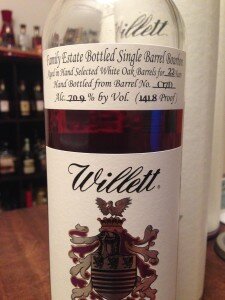 TASTE:Shockingly, I could not find the amount of cherry teased by the initial nose. This was pervasive oak and caramel--not bad at all--just unexpected. There was no pepper either. Just oak and caramel.After a few minutes, the taste shifted to oak and old leather.Water did improve the taste on the first pour. I got a sea salted Mr. Goodbar with the same oak and a hint of raspberry and pomegranate seeds that came up right before the finish started. The heat was certainly still there, but the kick took a few seconds longer to onset.The second pour was sublime. Oh, every pour should be like the second pour! I mean, wow. It was so different after 48 hours open. I was blessed with a straight stunner first sip packed with the flavors you want to chase the rest of your life. I was going to split this second pour between neat and water. Then, I decided to split the second pour into two pours--one neat and one with water--so as to prolong the enjoyment of C17D neat.From the start of the second pour, I was punched with warm vanilla french toast and some bite from pure maple syrup that rolls into a cinnamon and chili-infused dark chocolate bar. The second pour had a taste that closed out with tiramisu sweetness. So fantastic.Water, unlike with the first pour, depressed the taste on my second pour. I got muted oak and leather, a bit of scented marker and some red berry. I was reminded of Old Charter 8YO if it came in a much higher proof.
TASTE:Shockingly, I could not find the amount of cherry teased by the initial nose. This was pervasive oak and caramel--not bad at all--just unexpected. There was no pepper either. Just oak and caramel.After a few minutes, the taste shifted to oak and old leather.Water did improve the taste on the first pour. I got a sea salted Mr. Goodbar with the same oak and a hint of raspberry and pomegranate seeds that came up right before the finish started. The heat was certainly still there, but the kick took a few seconds longer to onset.The second pour was sublime. Oh, every pour should be like the second pour! I mean, wow. It was so different after 48 hours open. I was blessed with a straight stunner first sip packed with the flavors you want to chase the rest of your life. I was going to split this second pour between neat and water. Then, I decided to split the second pour into two pours--one neat and one with water--so as to prolong the enjoyment of C17D neat.From the start of the second pour, I was punched with warm vanilla french toast and some bite from pure maple syrup that rolls into a cinnamon and chili-infused dark chocolate bar. The second pour had a taste that closed out with tiramisu sweetness. So fantastic.Water, unlike with the first pour, depressed the taste on my second pour. I got muted oak and leather, a bit of scented marker and some red berry. I was reminded of Old Charter 8YO if it came in a much higher proof.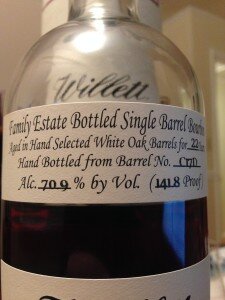 FINISH:The first pour finished warm and everlasting. I usually expect a big proofer with this much age to be very dry with a bite on the sides of the tongue. C17D started mid-palate and then moved to the tip of the tongue with cinnamon red hot heat that subsided and went back to squarely mid-palate oak and leather. The mid-palate finish was unique because it felt like I had a round peppermint sitting heavy smack dab in the middle of my tongue giving off cool, minty heat. That doesn't mean that it tasted minty like Four Roses. It had that cool, lasting menthol effect that you get from strong breath mints. Oaky. Again, long. Most interestingly, however, there was a heartburn feel on the chest. This was the first bourbon I have had that put pressure on the chest.With water, that mid-palate finish left and instead sat on the very tip of the tongue and the back sides of the tongue. Yet, the heartburn grip remained. Again, oaky, but cherry cordial peaked out at the very end of the finish. C17D--she grips and steps on your chest.The first pour's taste and second pour's taste produced widely different reactions. Likewise, the second pour's finish came out with a new look. The finish was still long and warm, but this time it was jammed with salty caramel, salty peanuts (Beam like) and oak. It didn't start as dry as the first pour, but closed its act very dry. C17D--she no longer grips and steps on your chest. Instead, she has that nice fireside winter warming burn. Perhaps the only similarity was that the finish still sat squarely on the mid-palate. Although, even that aspect was more subdued because of the numbing front-palate and top of the mouth burn.With water, I just got oak and stale cinnamon red hots as though the red hot flavor was an aftertaste from chewing Big Red gum.
FINISH:The first pour finished warm and everlasting. I usually expect a big proofer with this much age to be very dry with a bite on the sides of the tongue. C17D started mid-palate and then moved to the tip of the tongue with cinnamon red hot heat that subsided and went back to squarely mid-palate oak and leather. The mid-palate finish was unique because it felt like I had a round peppermint sitting heavy smack dab in the middle of my tongue giving off cool, minty heat. That doesn't mean that it tasted minty like Four Roses. It had that cool, lasting menthol effect that you get from strong breath mints. Oaky. Again, long. Most interestingly, however, there was a heartburn feel on the chest. This was the first bourbon I have had that put pressure on the chest.With water, that mid-palate finish left and instead sat on the very tip of the tongue and the back sides of the tongue. Yet, the heartburn grip remained. Again, oaky, but cherry cordial peaked out at the very end of the finish. C17D--she grips and steps on your chest.The first pour's taste and second pour's taste produced widely different reactions. Likewise, the second pour's finish came out with a new look. The finish was still long and warm, but this time it was jammed with salty caramel, salty peanuts (Beam like) and oak. It didn't start as dry as the first pour, but closed its act very dry. C17D--she no longer grips and steps on your chest. Instead, she has that nice fireside winter warming burn. Perhaps the only similarity was that the finish still sat squarely on the mid-palate. Although, even that aspect was more subdued because of the numbing front-palate and top of the mouth burn.With water, I just got oak and stale cinnamon red hots as though the red hot flavor was an aftertaste from chewing Big Red gum.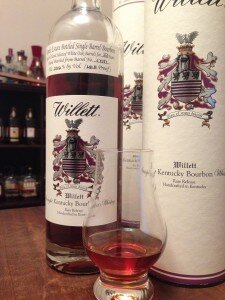 CONCLUSION:I prefer C17D neat to water. I would suggest taking a few quick nips on a fresh pour and then let air do its magic. I am very excited about the way the bottle improved after opening. I have had a few recent bottles that peak on the first pour. I want a bourbon that gets better with each pour until, inevitably around the half-empty mark, simple nature starts its work and its time to get into maintenance mode.How does this compare to C14D, another 22-year-old wheated bourbon released not long before C17D? Too hard for me to say. I like the nose on C17D considerably better after both pours, with "considerably" being as big a difference as you can squeeze when you are at this level of quality. As for the taste, C14D was considerably better (again, caveat) after my first C17D pour, and that one-off Tootsie Roll pop flavor takes the crown, but my second C17D pour hit nearly all of the warm, rich dessert flavor I want in my baseline for an elite bourbon. This is a push. The finish on C14D wins the flavor battle between the two, but C17D had that unique chest pinch and pressure on the first pour that kept me more focused than the flavor of the C14D finish. Flip a coin, I say.SCORE:Nose -8.5/10.0 Day 18.5/10.0 Day 2(Nose weighted 35%) = 2.98Taste -9.25/10.0 Day 19.5/10.0 Day 2(Taste weighted 45%) = 4.22Finish-7.5/10.0 Day 17.0/10.0 Day 2(Finish weighted 20%) = 1.45TOTAL = 8.65/10.0******9.5-10.0 bourbon basically does not exist in my scoring system. It is a figure left for the life-altering bourbons.9.0-9.5 bourbon is as best as they come.8.5-9.0 bourbon is fantastic, and it is a mark that a limited edition release should hit. Obviously, not all do.8.0-8.5 bourbon is a bourbon that likely has one superb feature and above average remainders, or it is a bourbon that is more than above average across the board. This is a mark that a limited edition release must hit to avoid underperformance.7.0-8.0 bourbon is a bourbon that is probably above average across the board. There may be one close to average aspect about it. This is the worst bourbon that I want to pour each night when I am rich.6.0-7.0 bourbon is a bourbon with nearly every facet near average, but not yet average. Expect slightly less reviews to fall here.5.0-6.0 bourbon is average bourbon. Expect most reviews to fall here.4.0-5.0 bourbon is a bourbon with nearly every facet near average, but on the wrong side of average. Expect most reviews to fall here.3.0-4.0 bourbon is a bourbon with probably one average or near average aspect, with the others being below average. Expect slightly less reviews to fall here.2.0-3.0 bourbon is solidly below average bourbon. I suspect I could be reviewing a few of these bourbons.1.0-2.0 bourbon is bad. I hope I do not have to review many bourbons in this category.0.0-1.0 bourbon should be avoided at all costs. I highly doubt I ever review a bourbon in this category.
CONCLUSION:I prefer C17D neat to water. I would suggest taking a few quick nips on a fresh pour and then let air do its magic. I am very excited about the way the bottle improved after opening. I have had a few recent bottles that peak on the first pour. I want a bourbon that gets better with each pour until, inevitably around the half-empty mark, simple nature starts its work and its time to get into maintenance mode.How does this compare to C14D, another 22-year-old wheated bourbon released not long before C17D? Too hard for me to say. I like the nose on C17D considerably better after both pours, with "considerably" being as big a difference as you can squeeze when you are at this level of quality. As for the taste, C14D was considerably better (again, caveat) after my first C17D pour, and that one-off Tootsie Roll pop flavor takes the crown, but my second C17D pour hit nearly all of the warm, rich dessert flavor I want in my baseline for an elite bourbon. This is a push. The finish on C14D wins the flavor battle between the two, but C17D had that unique chest pinch and pressure on the first pour that kept me more focused than the flavor of the C14D finish. Flip a coin, I say.SCORE:Nose -8.5/10.0 Day 18.5/10.0 Day 2(Nose weighted 35%) = 2.98Taste -9.25/10.0 Day 19.5/10.0 Day 2(Taste weighted 45%) = 4.22Finish-7.5/10.0 Day 17.0/10.0 Day 2(Finish weighted 20%) = 1.45TOTAL = 8.65/10.0******9.5-10.0 bourbon basically does not exist in my scoring system. It is a figure left for the life-altering bourbons.9.0-9.5 bourbon is as best as they come.8.5-9.0 bourbon is fantastic, and it is a mark that a limited edition release should hit. Obviously, not all do.8.0-8.5 bourbon is a bourbon that likely has one superb feature and above average remainders, or it is a bourbon that is more than above average across the board. This is a mark that a limited edition release must hit to avoid underperformance.7.0-8.0 bourbon is a bourbon that is probably above average across the board. There may be one close to average aspect about it. This is the worst bourbon that I want to pour each night when I am rich.6.0-7.0 bourbon is a bourbon with nearly every facet near average, but not yet average. Expect slightly less reviews to fall here.5.0-6.0 bourbon is average bourbon. Expect most reviews to fall here.4.0-5.0 bourbon is a bourbon with nearly every facet near average, but on the wrong side of average. Expect most reviews to fall here.3.0-4.0 bourbon is a bourbon with probably one average or near average aspect, with the others being below average. Expect slightly less reviews to fall here.2.0-3.0 bourbon is solidly below average bourbon. I suspect I could be reviewing a few of these bourbons.1.0-2.0 bourbon is bad. I hope I do not have to review many bourbons in this category.0.0-1.0 bourbon should be avoided at all costs. I highly doubt I ever review a bourbon in this category.
SF Crusader: Loch & K(e)y Knob Creek Single Barrel Reserve 2015
Jim Beam puts out a lot of whiskey. In addition to their signature brand, the Clermont distillery is responsible for a set of bourbons they call their Small Batch Bourbons - these are Knob Creek, Basil Hayden's, Booker's and Baker's. It also produces Old Grand-Dad but this post is going to focus on the Knob Creek brand.Within this brand there are a few expressions. The standard 100-proof small batch, a rye (also 100 proof), a flavored "Smoked Maple" and last but not least a single barrel 120-proofer.On a recent trip to Kentucky I had the pleasure of spending a delightful day visiting the Jim Beam facility and participating in a barrel pick (as detailed in this excellent writeup by bourbonooga). The usual single barrel disclaimers apply here: different barrels of bourbon can exhibit wildly different tastes even if everything else (distillation batch, barrel date, age, etc.) remain the same.We picked from three barrels and this was the obvious favorite. I remember distinctly thinking "this is it" when I first tried it, and though I also tried to keep an open mind and sample each a few times, my first impression was right.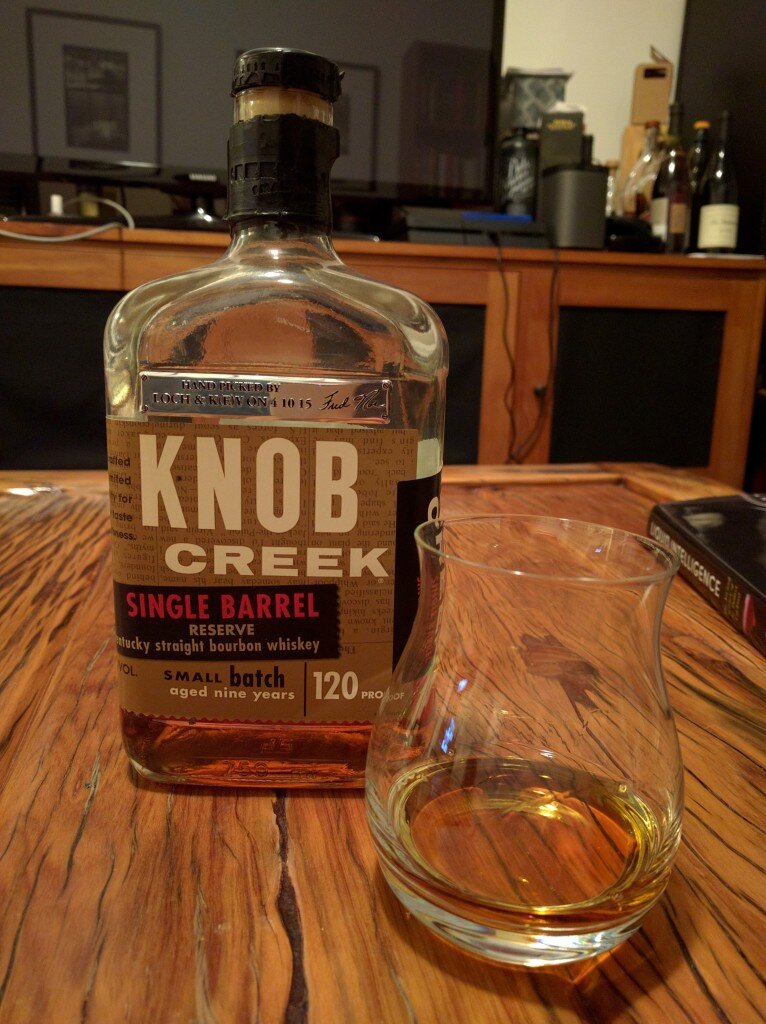 On the nose I get a pretty hot blast of alcohol, which makes sense as this is fairly overproof, but also some darker cherry notes and a smell that I'm going to describe as a little glue-y but in a good way (make what you will of that). After a few minutes the initial cherry has deepened slightly into a cherry-caramel smell that I can almost chew on.On the tongue there is a blast of cherry cola along with no small amount of oak barrel - the high proof along with the oak really help elevate this bourbon, as although it isn't the most complex whiskey I've ever tasted, it is definitely better than other Knob Creek bottles I've tried.On the finish cherry remains predominant, gaining a slightly medicinal and syrupy quality (think: the best cherry cough syrup you have ever tasted).Upon adding water, I'm amazed at how the nose opens, with that strong cherry now taking a backseat to lighter caramel-vanilla-toffee along with a slight tanginess reminiscent of dried apricot (though with no other qualities of that fruit). The nose smells really, really good. Maybe even a minor walnut note? I'm getting some pepper spice on the palate now, in addition to a hint of smokiness which also complements the flavors immensely. Definitely some leather in there as well.A pleasant sensation of crushed black pepper dances across the tongue during the finish,In sharp contrast to the Booker's 25th Anniversary (also produced by Jim Beam), water improves this Knob Creek Single Barrel considerably. After adding a couple drops of water this is a pretty delicious and well-balanced drink, although certainly on the toothier, heftier side.Rating: 3.5 / 5
On the nose I get a pretty hot blast of alcohol, which makes sense as this is fairly overproof, but also some darker cherry notes and a smell that I'm going to describe as a little glue-y but in a good way (make what you will of that). After a few minutes the initial cherry has deepened slightly into a cherry-caramel smell that I can almost chew on.On the tongue there is a blast of cherry cola along with no small amount of oak barrel - the high proof along with the oak really help elevate this bourbon, as although it isn't the most complex whiskey I've ever tasted, it is definitely better than other Knob Creek bottles I've tried.On the finish cherry remains predominant, gaining a slightly medicinal and syrupy quality (think: the best cherry cough syrup you have ever tasted).Upon adding water, I'm amazed at how the nose opens, with that strong cherry now taking a backseat to lighter caramel-vanilla-toffee along with a slight tanginess reminiscent of dried apricot (though with no other qualities of that fruit). The nose smells really, really good. Maybe even a minor walnut note? I'm getting some pepper spice on the palate now, in addition to a hint of smokiness which also complements the flavors immensely. Definitely some leather in there as well.A pleasant sensation of crushed black pepper dances across the tongue during the finish,In sharp contrast to the Booker's 25th Anniversary (also produced by Jim Beam), water improves this Knob Creek Single Barrel considerably. After adding a couple drops of water this is a pretty delicious and well-balanced drink, although certainly on the toothier, heftier side.Rating: 3.5 / 5










